- Home
-
SHOP ECO FARM
- ECO Farm Grow Lights
- ECO Farm LED Grow Lights
- ECO Farm Quantum Board
- ECO Farm Samsung LED Grow Lights
- ECO Farm COB Grow Lights
- ECO Farm Commercial Lights
- ECO Farm Supplemental Grow Light
- ECO Farm Fluorescent grow lights
- ECO Farm HPS & MH Grow Lights
- ECO Farm CMH Grow Lights
- ECO Farm HID/CMH Bulbs & Ballasts
- ECO Farm Grow Tents & Kits
- ECO Farm 2x2ft Grow Kits
- ECO Farm 3x3ft Grow Kits
- ECO Farm 3.3x3.3ft Grow Kits
- ECO Farm 4x4ft Grow Kits
- ECO Farm 5x5ft Grow Kits
- ECO Farm Grow Tent - Standard Style
- ECO Farm Grow Tent - Extension & Roof & Lodge Style
- ECO Farm Extraction & Harvest
- ECO Farm Rosin Press Machine
- ECO Farm Dry & Wet Trimmers
- ECO Farm Oil Accessories
- ECO Farm Medicinal Plants Grinder
- ECO Farm Medicinal Plants Containers
- ECO Farm Medicinal Plants Dryer
- ECO Farm Refrigeration Dryer
- ECO Farm Climate Control & Other Accessories
- ECO Farm Inline Duct Fans
- ECO Farm Oscillating Fans
- ECO Farm Exhaust Fans
- ECO Farm Air Filter
- ECO Farm Duct Muffler
- ECO Farm Ventilation Kits
- ECO Farm Plant Humidifiers
- ECO Farm Plant Dehumidifiers
- ECO Farm Hydroponic Accessories
- ECO Farm Other Accessories
- ECO Farm Hydroponics Microscopes
-
TOP BRANDS
- Grow Lights Brands
- Adjust-A-Wing
- Apollo Horticulture
- Bestva
- Black Dog LED
- California Lightworks
- ChilLED Grow Light
- Eco Farm
- HLG - Horticulture Lighting Group
- Kingled
- Kind LED
- Mars Hydro
- Morsen
- Neilo
- NextLight
- Phlizon
- PlatinumLed
- Roleadro
- Optic LED Grow Lights
- ViparSpectra
- Vivosun
- EYE Hortilux
- IPOWER
- NanoLux
- Phantom grow light
- Gavita grow lights
- Grower's Choice
- Lumatek
- Maxibright
- Yearld Pro
- ThinkGrow
- Crecer Lighting
- Green Sunshine Electric Sky
- fohse aries
- loriflux
- luxx
- fluence
- iluminar
- Lex
- LTC
- Rayonled
- FGI
- PHOTONTEK
- Grow Tents & Kits Brands
- Apollo Horticulture
- Black Box
- CoolGrows
- Eco Farm
- GrowLab
- Gorilla Grow Tents
- Mars Hydro
- Quictent
- Secret Jardin
- Unit Farm
- TopoGrow
- VIVOSUN
- Topolite
-
COMPANY INFO
-
COOPERATE WITH US
- Blog
3 Best LED Grow Lights for Your Indoor Garden in 2023
February 02, 2023
With so many options on the market, finding the best LED grow lights for your indoor garden can be understandably tricky.
LED grow lights are becoming more and more popular in indoor gardening and hydroponic systems. They offer many advantages over traditional HID (High Intensity Discharge) lighting, including lower energy consumption, less heat output and a longer lifetime.
Why are grow lights so great?
If you want to grow indoors, you may need a grow light.
There are some major benefits to using grow lights. They will keep your plants growing even with other changes in the weather outside.
Plants need sunlight to grow. Once it’s bedtime, they have to stop growing for a few hours until the sun comes out. With LED grow Light you can create an always sunny environment for your plants — so they keep growing and you can harvest them faster.
The biggest benefit is flexibility. Grow lights really open the door to a world of gardening adventure. Whether you want to grow pineapples in the Antarctic or leafy greens in the desert, grow lights can create the perfect environment for your plants, no matter where you are.
Another benefit is that you can create an even distribution of light. In a garden, plants may be prone to shade for most of the day; this means they don’t get as much light from the sun. Grow lights, on the other hand, can help distribute light evenly throughout the plant’s canopy.
ECO Farm MB720 Foldable Grow Light Bar

Features:
ECO Farm LED grow light is equipped with Samsung LM301B LED chip, using Osram 660nm chip, the light output is as high as 2.7 μmol/J, the PPF output is 1944 umol/s, the photons are completely evenly distributed in the 5×5ft coverage area, reducing energy consumption while increasing power , more efficient and energy-efficient than traditional HPS. The slim bar design shines with the latest aluminum heatsinks for better airflow and excellent cooling without noise. Patented reverse folding design, 180° perfect flat, LED waterproof coating, no fear of wet environment, built-in power supply, no messy wires. This grow light reduces the ambient heat in the growing space, prolongs the service life, and also expands the heat dissipation area.
HEO 1700Pro 700 Watt LED Grow Light
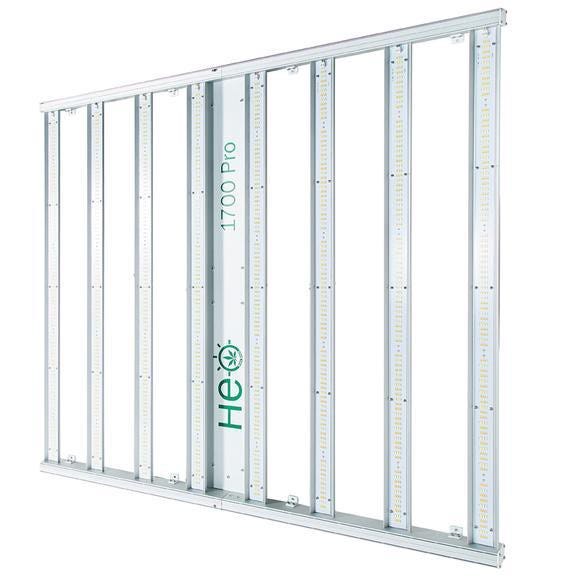
Features:
The HEO 1700Pro 700 Watt LED Grow Light is an excellent light for any and all phases of a plant growing lifecycle, whether you’re using it in a tent for your personal indoor garden or chained together in a large commercial operation. The 1700 Pro’s 8 powerful lighting bars focus their intense light evenly across your plant canopy for healthy, potent, high-yielding plants. The HEO 1700Pro 700 Watt LED Grow Light delivers full-spectrum light to a 4'x 4'area for flowering and a 5'x 5'area for veg. The high efficacy of 2.4 µmol/j and up to 630–700 wattage power consumption make this a productive and affordable indoor grow lighting solution.
EYE HORTILUX Ascend LED 700-ES Grow Light
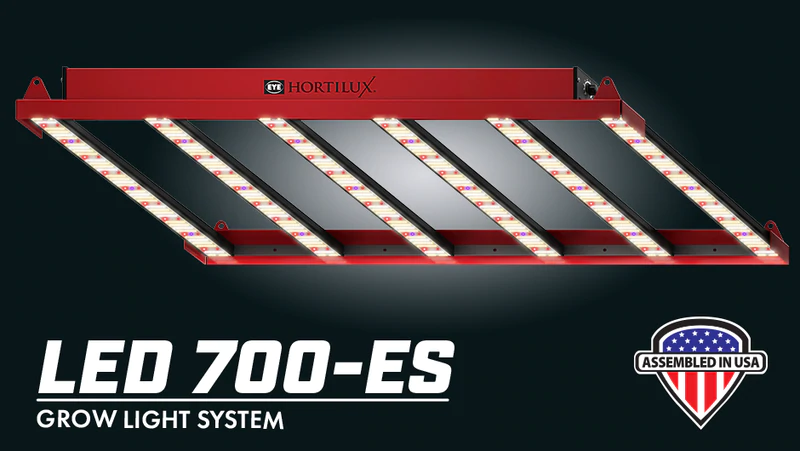
Features:
EYE HORTILUX LED uses upgraded SMD LED technology, which can save energy up to 50% compared to other HPS grow lights. It can provide strong light output and uniform penetration to achieve higher output. It is with incredible power and light that can cultivate healthier plants from beginning to end. Compared with other ordinary lighting equipment, LED grow lights are gentler and will not scorch seedlings. Use plant growth lights to improve productivity. The shell is made of sturdy aluminum alloy, fast heat dissipation, high performance. Built-in dimmer switch, simple and convenient. The nine-position dial will allow you to set the level you want for the stage of growing you are in. Adjust to a suitable position to adapt to the different growth cycles of plants. This full-spectrum lamp is infinitely close to natural sunlight, very suitable for the entire stage of indoor plant growth.
How to Choose LED Grow Lights
By now you may have noticed that we love LED grow lights. They’re super efficient, easy to use, and perfect for small or commercial grow spaces. All kinds of not loving?
We almost always recommend LED grow lights to our customers and feature only the best on the market on our website.
But not everyone is the same…
There are many manufacturers who will deliberately exaggerate the capabilities of their LEDs. Some people focus on the wattage of the bulb — as we mentioned above — when it comes to LED grow lights, it doesn’t always mean more power or efficiency.
Others might just combine blue and red diodes into one light and call it “full spectrum”. But in the end, you’ll end up needing supplemental lighting to make sure your plants have everything they need.
Some manufacturers will also brag about the coverage of their grow lights. But rather than be disappointed with the results, we recommend pushing your plants into the center of your growing space and lighting it accordingly. Otherwise, the plants on the sides will suffer (literally) in the shade.
How to Calculate the Coverage of LED Grow Lights
When looking at coverage, the object of the game is to give your plants as much light as possible at any given time. This can be done by measuring the canopy of the plants and buying some grow lights to cover the entire space, or by making sure the plants are directly under the light source and away from the sides of the growing area.
Unfortunately, traditional non-LED grow lights are easier to calculate coverage. With LEDs, it’s a bit trickier and by no means a one-size-fits-all solution. A general rule of thumb is light output/desired light intensity, but this may need to be adjusted depending on your space and plant types.
Conclusion
If you buy the right LED grow light after checking various aspects such as coverage area, efficiency, PAR value, heat emission, etc., it will be very beneficial for your indoor growing. We hope our detailed LED grow lights buying guide was helpful for you in choosing the best LED grow lights for commercial spaces and small rooms.
Best 480W LED Grow Lights for Plant Growth in 2023
February 01, 2023
You already know when your houseplants need water, and you pay close attention to temperature, ventilation, and humidity levels. However, it could just be that no matter how many windows you have, you just don’t get perfect light in certain months. It could also be that you place the plant in an environment that needs a little help from light. Whatever the reason, it’s important to invest in LED grow lights, which can also help you save energy.
You want a happy home that includes happy plants and an electric bill that doesn’t make you want to tear it up, crump it up and throw it in the trash! The good news is you have a few different options. Below, we highlight some of our picks for LED grow lights that can help you grow your plants and help you save energy. We showcase different styles at different price points to give you options that you can use.
Advantages of LED Grow Lights
The first advantage of LED grow lights is their efficiency. Their high efficiency reduces energy bills and brings long-term benefits.
Little to no heat is generated because most of the energy is converted to light energy. Temperature regulation is easier and does no harm to the plants.
The brightness of the LEDs can be controlled and adjusted according to the growth stage of the plants. In addition, the correct spectrum can be selected to ensure optimal growth.
LED grow lights are durable. While the upfront costs are high, these are cost-effective in the long run. Depending on quality, they can last 50,000 hours or more.
They are suitable for almost any indoor farm, no matter the size. These lights can even be used on home/garage farms. They are very compact in size and easy to handle and place.
ECO Farm DBL5000 Full Spectrum LED Grow Light 480W
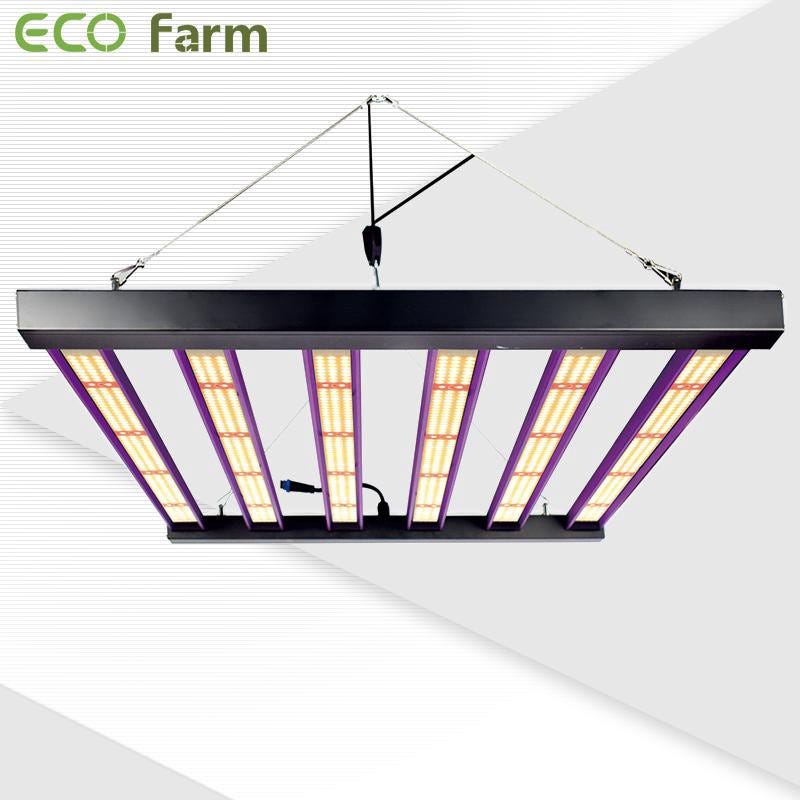
Features:
With 1296 pcs SAMSUNG LM281B diodes, ECO Farm Led grow lights draw 480 watts achieving an impressive PPE of 2.5 umol/J, coverage for 4'x4′ of high-yielding full-cycle growth. with a smaller footprint for better crop quality, more cost-effective. 4x4ft for personal grow, 3x3ft for commercial grow. Built-in removable bars interval & disability enable the exact dynamic PPFD control over each of plant growing stages. Easy dimming & daisy chain max up to 15 lights, IP65 Waterproof, master light easily controlled, making it a high-performance commercial grow light for enormous yields. Also perfectly suit full-cycle hydroponic, soil, grow tent/room growing.
Fluence SPYDR 2i 33" LED Grow Light
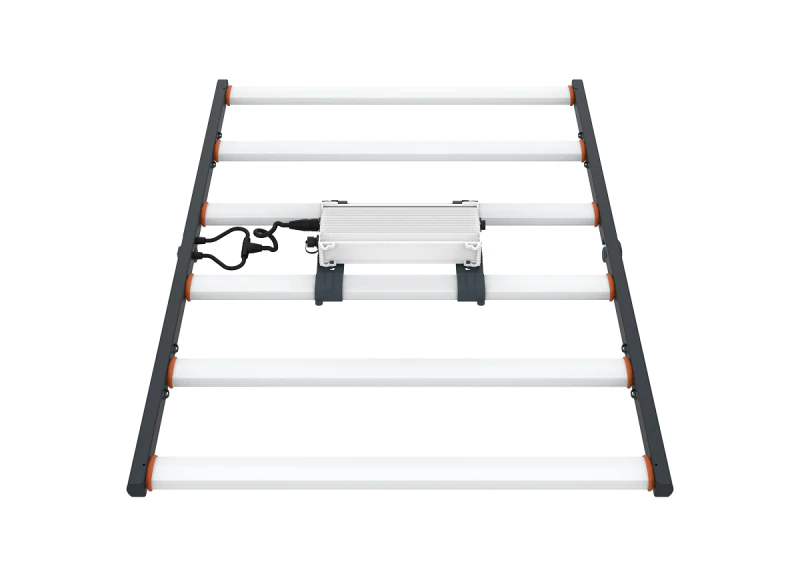
Features:
The Fluence LED grow light is designed for multi-layer cultivation — from vegetable to flowering — with a PPF of up to 1,250 µmol/s for the 2i 33". SPYDR 2i is a high performance toplighting solution for commercial horticultural cultivation. Designed for growers Pushing the limits with high PPFD cultivation practices. Not suitable for growing without supplemental CO2. With an upgraded form factor, the SPYDR 2 series is a plug-and-play solution that works out of the box for faster installation. All SPYDR models can be dimmed with our light intensity dimmers for precise control of PPFD , and provides flexibility to instantly adapt to new crop requirements with different light.
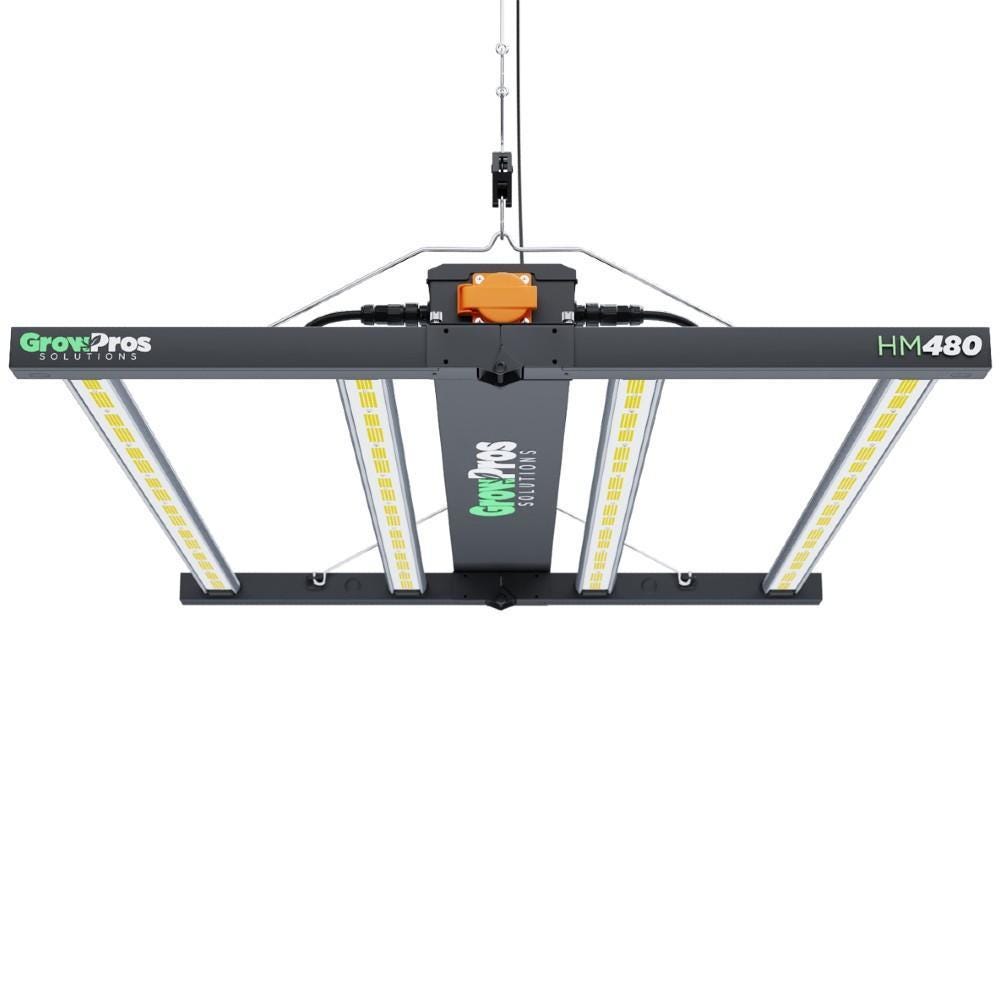
Features:
This GrowPros grow light, with an increased lifespan over traditional grow light sources, cultivates healthier, happier plants. The HM480 Series produces 1.8 gram per watts (dried) of crop yield. A high-PPFD and PAR indicates high efficacy, or light output produced per expenditure of unit of power. Generating about 50% more in energy savings over traditional HID and HPS light sources, the HM480 gives you meaningful savings over time. Will not produce the same results without CO2 supplementation. A full-spectrum LED rack lighting solution designed for commercial indoor and greenhouse applications, enabling control over the plant cycle from the vegetative stage to the flowering stage.
Things to Consider When Buying Lights for Your Indoor Plants
Type
The size and construction of your greenhouse will determine what kind of grow lights you need. Small personal greenhouses require different greenhouse lights than larger commercial greenhouses.
For example, commercial greenhouses need to grow lights that can withstand the wet, harsh conditions that are primarily found in commercial environments.
Spectrum
Since plants need PAR (Photosynthetically Active Radiation) light, you should choose grow lights with the right wavelength. PAR light is between 400 and 700nm.
Electrical Efficiency
You should always determine the efficiency of a product before making a purchase. This will ensure you get maximum results without costing you an arm and a leg. Find grow lights that are efficient and low energy consumption.
Heat
Plants require a certain level of heat below or above which can be harmful to the plant. This means you should always choose a grow light that offers ideal heat dissipation. Some lights produce too much heat, while others produce too little.
Conclusion
With the simple and easy way to grow plants indoors using grow lights, you can get started and decide if you like doing it. It can take some time to master indoor gardening and get used to its nuances compared to outdoor gardening. However, once you start gardening, it can be a rewarding reward for your love of gardening. It’s nice to take a change of pace from worrying about bugs or the weather.
The Hottest 700W LED Grow Lights for 2023
January 31, 2023
There is no doubt that sunlight is one of the most important factors for plant growth and overall health. While some plants need direct sunlight to survive, others thrive in the shade or in part sun. But what if your home or garden doesn’t get a lot of sun and you have nowhere to move? This is where grow lights come into play and why they are the lucrative business they are today.
This guide shares the hottest grow lights for 2023 to make the selection process easier for your business portfolio.
Why do greenhouses need grow lights?
It’s no surprise that plants cannot grow without light. Plants need light for photosynthesis, which allows them to convert light, oxygen and water into the energy they need to grow and develop.
But not all light is created equal. Chlorophyll in plants responds to specific wavelengths of light, with maximum light absorption when exposed to red and blue light or light in the 400–700 nanometer range. Green light is roughly in the middle of the spectrum and is not easily absorbed, but this allows it to penetrate deeper into leaf tissue.
We do not recommend using household bulbs for growing plants. While incandescent bulbs are cheap and provide a continuous light spectrum, they need to be placed away from plants because they emit too much heat and burn foliage. Also, an average lifespan of around 1,000 hours makes them extremely inefficient.
On the other hand, the blue light from fluorescent bulbs promotes lush plant growth, making them an attractive option. They are generally cooler and more energy efficient than incandescent bulbs. However, neither incandescent nor fluorescent lights are ideal for efficient and healthy plant growth.
Grow lights are designed to meet the spectral needs of all stages of plant growth and are the most efficient choice for greenhouse growers. Whether you’re starting a seedling or looking to grow fruits and vegetables throughout the winter, grow lights are must-have greenhouse accessories.
ECO Farm YS SERIES 700W LED Grow Light
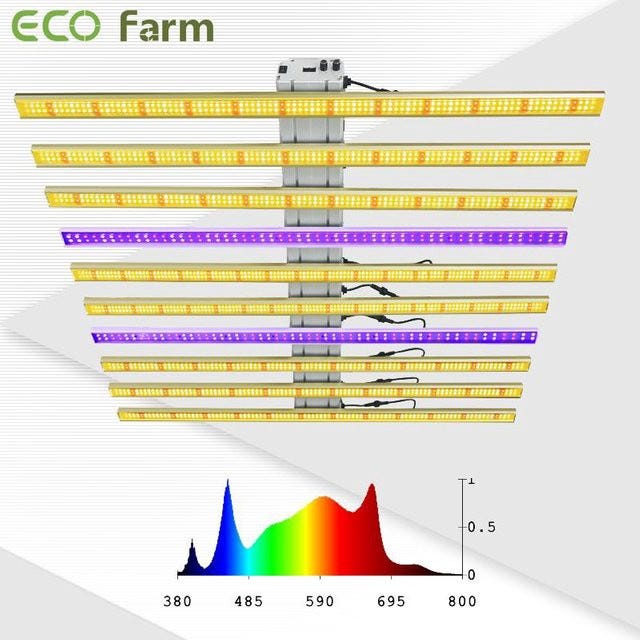
Features:
This ECO Farm LED grow light provides high energy efficiency at 2.7umol/J.The best solution to get more and better quality fruits. The light intensity can be changed by dimmer knob according to the different growth stages of plants. If in a grow tent, over 90% of reflected light can be absorbed by plants. Adequate and sun-like light can prevent the growth of plants from spindly and moulding. The best lighting solution for indoor hydroponics and soil cultivation. The actual power is 700w. Increasing the heat dissipation area by utilized a special surface treatment of the aluminum heat sink. Saving up to 50% energy and 30% cooler than than other grow lamp. Low energy consuming fast heat dissipation. No fan. IP65 Waterproof and mute. This dimmable LED grow light so that you can adjust the brightness without frequently changing the position of the light. 1–23 hour timer for hassle-free light cycling control.
Maxibright JUNO PRO — 720W LED Grow Light
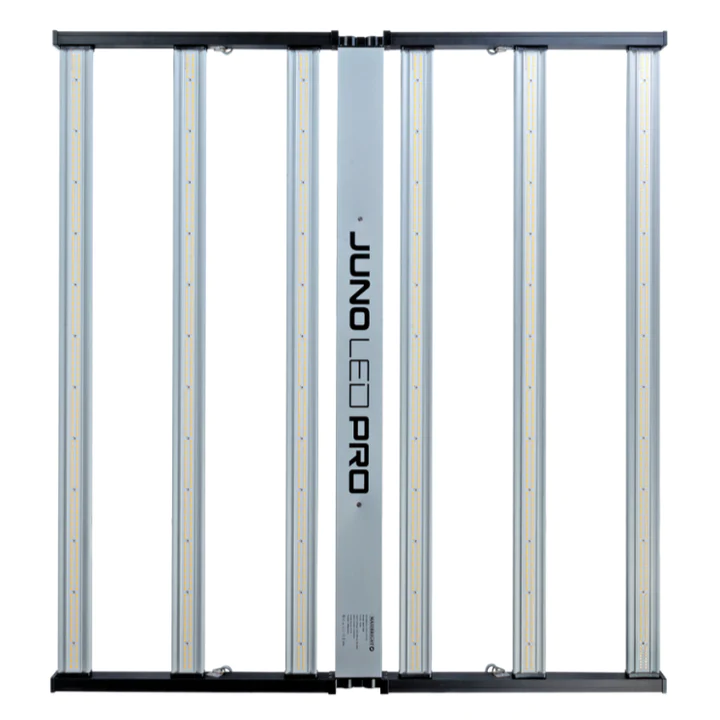
Features:
The Maxibright LED Grow Light is an affordable and powerful 720 watts, has an output of 1800 micromoles per second (PPF), and is optimized to cover an area of 1.5 m x 1.5 m. 6 LED strips to provide uniform full spectrum light with added red spectrum for enhanced blooming. The whole luminaire folds in half, is very easy to transport, and unlike other LED units on the market, it is truly plug-and-play and requires zero assemblies of any kind. At only 40mm high, it maximizes the usable height in any growing space. Juno uses all-new MaxiLED chips. These high-quality chips are hand-picked by Maxirow and will provide the perfect spectral output for high-yielding plants. Each unit comes with a remote dimmer that allows you to adjust the light from 25% — 50% — 75% — 100% power. This is especially useful for growing young plants that don’t require as much light as more mature flowering plants.
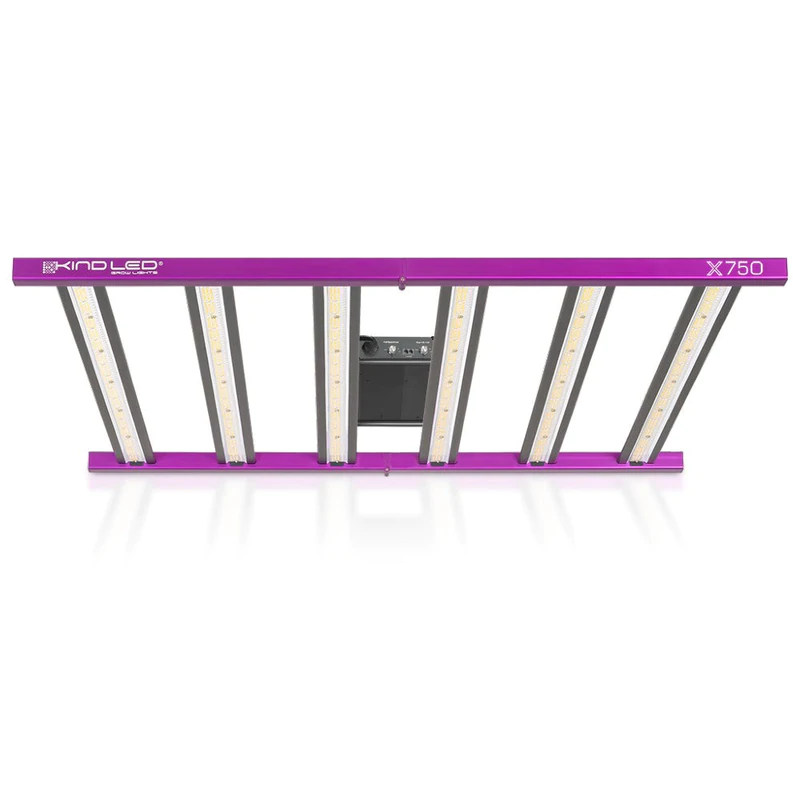
Features:
Kind LED grow light uses top-of-the-line Osram and Phillips diodes to produce targeted full-spectrum light as well as UV and IR to enhance your plants during flowering. The KIND X750 uses the full spectrum white LED diodes used by top LED companies. Kind’s Targeted Full Spectrum is designed for plants to maximize harvest weight and plant quality. Our spectrum is the result of hundreds of thousands of hours of field testing in the Northern California medicinal plant industry. With 750 watts of power and a 4' x 4' footprint, the X750 is powerful enough for commercial growers while still being compact enough for single planting.
Advantages of LED lighting
Greater Efficiency: Generally, LED lights consume less energy than other types of grow lights. This means less electricity bills and a smaller carbon footprint for you. LEDs also last longer than fluorescent or HID lights, so you won’t have to replace them as often.
Longer Lifespan: As mentioned above, LEDs last longer than other types of grow lights. A good LED grow light will last at least 50,000 hours before needing to be replaced, and some LEDs can even keep running for over 60,000 hours.
Cooler: LEDs also generate much less heat than other types of grow lights. That’s great news if you’re running lights in a small house or apartment, because it means you don’t have to worry about overheating damaging your house. However, be careful if you live in a hot climate as your LED grow lights may not keep cool enough on their own. It might be a good idea to invest in LED fans and other cooling tools.
Full Spectrum: LEDs can produce a wide range of wavelengths to give your plants all their nutritional needs. That’s why LEDs have become so popular among indoor gardeners: They make it easy to maintain ideal growing conditions, leading to bigger and better harvests.
Do different plant stages need different grow lights?
Plants benefit from different light ratios at different stages of their life cycle. For example, seedlings do best in more blue light, while plants need more red light for flowering and fruiting.
Many greenhouse grow lights offer a balanced “full” spectrum that can meet the needs of all plant stages. That said, some grow lights can be switched between different modes (for example, red light versus blue light) to enhance foliage or bloom as desired.
For most hobby greenhouse growers, buying and installing different grow lights is not necessary. If you want to switch between different light colors, just choose a single grow light with these modes. However, for most uses, full-spectrum grow lights support healthy plant growth in all stages.
Conclusion
Grow lights are the best way to help plants grow in a dark and airy house. Since lighting is such an important aspect of a friendly indoor farming environment, choosing the right grow lights can make or break a gardening job. This is exactly why, as farming continues to evolve, it is essential to stay abreast of the latest and upcoming trends and technologies.
Consider adding these grow lights to your portfolio and have a profitable and thriving fiscal year in your business trajectory!
What Factors Should be Considered when Choosing LED Grow Lights? (2023 Updated)
January 05, 2023
When you read this article, you definitely need to buy LED grow lights, which can help plants grow better and get some value. Although most plants are hardy, they still require more careful care.
If you don’t know much about LED plant growth lights and want to know more about the working principle of LED plant growth lights, then Xiaobian will explain to you LED plant growth lights and what is the best choice for LED plant growth lights. I hope you will benefit a lot after reading this article.
Benefits of Using Grow Lights
Are LED grow lights good for plants? yes! In particular, the predominance of far-red light in full-spectrum commercial grow lights is impressive. While blue and green wavelengths help keep houseplants dense and compact, recent studies have shown that far-red light is critical for optimal photosynthesis. A balanced color spectrum improves yields, but the benefits of good grow lighting go beyond speeding up growth. To make a residential or commercial grow light successful, LEDs bring many advantages.
Full Spectrum and Less Heat
Grow plants with LED lights while maintaining a constant indoor temperature without maxing out your utilities.
Cost-effective year-round cultivation
Keep your overhead low and keep your facility running year-round with high-efficiency LED grow lights rated for up to 50,000 hours.
Higher throughput and shorter production times
Because our LED garden lights provide full-spectrum light, you’ll grow bigger, denser, healthier plants in less time, which means a healthier bottom line.
High-quality plant grow bulbs are not just for commercial use. Whether you’re preparing your plants for winter, starting spring planting indoors, or caring for problem plants year-round, TCP Garden Lights allow you to:
Grow plants from different climates
Want fresh oranges from Ohio trees? Want to keep your orchids charming through the Wisconsin winter? No matter where you live, the right grow lighting can keep delicate plants happy.
Achieve greater plant growth
Win this silent race with your neighbors by supplementing your tomato plants with sunlight in full-spectrum grow light colors.
Start Garden Planting Early
Has a spring snowstorm ruined your early gardening dreams? Give plants like kale, cauliflower, and artichokes a head start with LED indoor grow lights.
Has a year-round plant nursery
When any of your plants shows signs of decay, an indoor nursery will give you the chance to save it. You can heal and grow plants with LED lights in your shed, garage, or enclosed porch as long as you have an available electrical outlet.
ECO Farm Z6–600 Samsung LM301B LED Grow Light
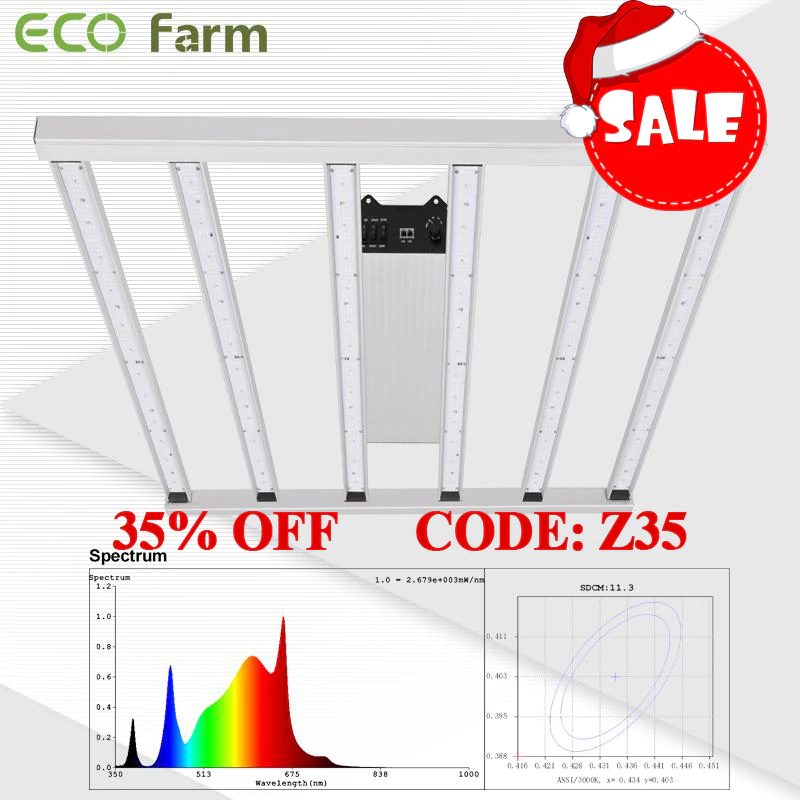
Features:
The PPE of the ECO Farm LED grow light is 2.7umol/J and the PPF is 1752umol/s, providing a high yield for light-loving plants. Energy saving and low heat compared to other types of grow lights. This is a LED grow light with 6 strips design, the light size expands to 4*4 feet. This will confirm evenly distributed coverage throughout the canopy, including the plant edges. Everbright coverage can reach 4*4~5*5 feet. The full spectrum is ideal for most light-loving plant seedlings, vegetation and the entire growth stage of flowering. IP65 waterproof horticultural lighting system can be used in humid or water vapour environments, easy to use, plug and play.
Fluence SPYDR 2i 40" LED Grow Light
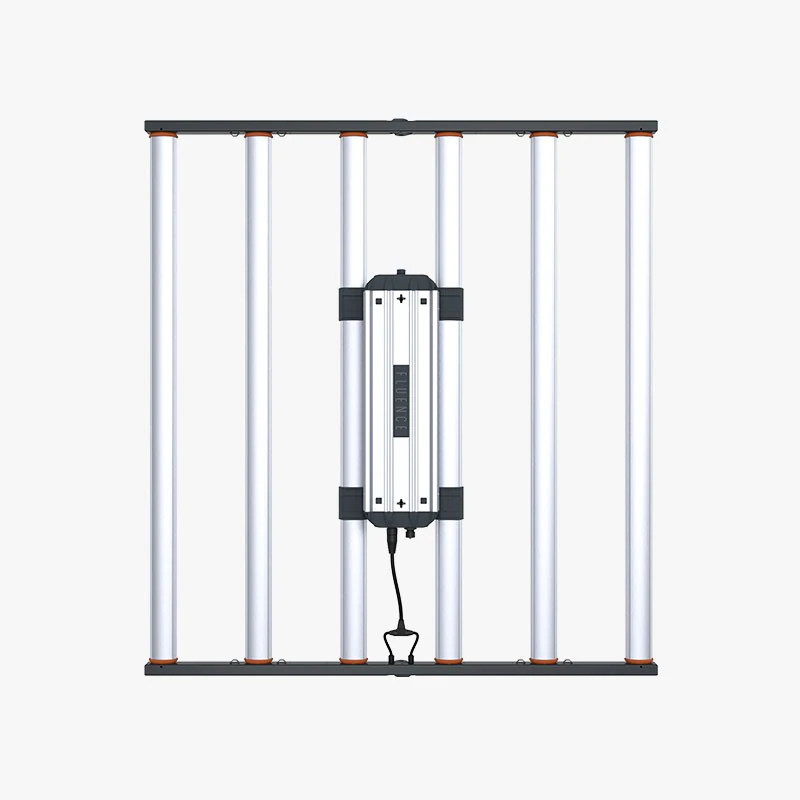
Features:
The Fluence LED grow light is designed for multi-layer growing — from vegetable to bloom — 2i 40" has a PPF of up to 1,600 µmol/s. SPYDR 2i is a high-performance top lighting solution for commercial horticulture growing. Designed for growers growing through high PPFD Practice pushes the limits. Not suitable for planting without supplemental CO2. With an upgraded form factor, the SPYDR 2 series works out of the box for faster installation and is a plug-and-play solution. The SPYDR series is ideal for use For multi-layer and single-layer applications including vertical farms, grow arches, tables and tents with adjustable aisles. SPYDR 2i 40" provides excellent coverage on 4' x 3.5' canopies.
Super Lumen Beam 600 Watt LED Grow Light
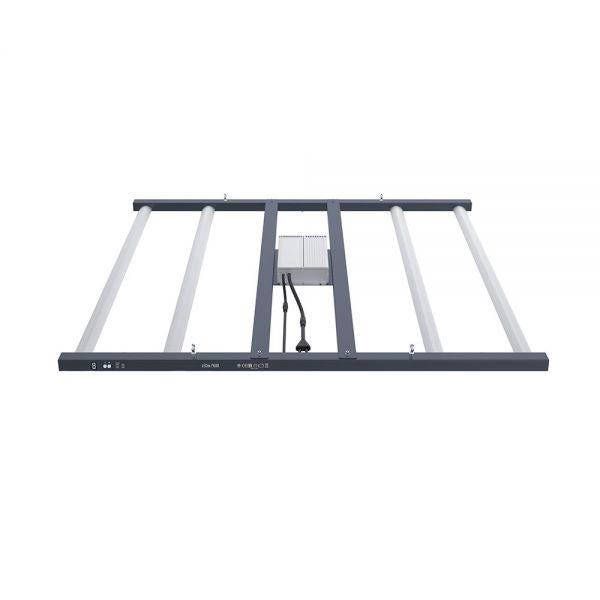
Features:
Grow from start to finish with the Super Lumen LED Grow Light and enjoy a stellar performance all the way through the plant lifecycle thanks to world-renowned Nanolux Technology. Flexible And User-Friendly Design. it can fold down to make for easier handling, transportation, and storage. Once positioned in your room or tent, you’ll see the digital control screen and buttons on the side of the fixture that allows you to adjust and monitor the dimmer setting — with output options including 100W, 200W, 300W, 400W, 500W, and 600W. The grow light got the LED bar protection function, which works in the highly unlikely event of a single bar failure, keeping everything else safely operating as normal whilst isolating the issue. Finally, the IP65 classification proves the LED is waterproof, moisture-proof, and dust-proof.
What factors should be considered when choosing LED plant growth lights?
Avoid cheap LED chips, well-known brands are durable and reduce future repair and maintenance costs. You can choose the right power for your application from 400W 600W 640W 720W 960W 1000W LED grow lights in the market.
There are no flickering issues (how to tell easily: test with a smartphone camera) or a lot of heat generation. If the frequency is above 100HZ, the naked eye may not be able to detect the flicker, but the camera can capture it. Severe flickering problems indicate that its driver is not good. If the lights generate too much heat, or you leave the lights on for more than 12 hours a day, then you will need a powerful and expensive cooling system to expel the hot air, otherwise, the plants may dehydrate and die, so keep an eye on the greenhouse ambient temperature.
Know what to plant, how tall the plants will grow, and determine the installation height.
Know the size of your growing area and the number of lights you need, then decide whether to use linear t8 tube grow lights or strip grow lights
Easy to use and flexible (if it can be dimmed by turning a knob set, or the intensity of the light can be programmed via a phone app, or the height of the hanging set can be coordinated with the adjustable rope according to different growth stages). If the growing area is so large, you don’t want to have to pull a power cord in it and need to control all the lights at once, so it’s good to have a connector that you can hook up to.
Tips for choosing the perfect accent light for your garden.
Grow lights are a great way to get plants growing in your garden. However, deciding which lamp to buy can be difficult. Here are some tips for choosing the perfect accent light for your garden:
1. Choose the right size light for your garden. Not all grow lights are suitable for all gardens, so make sure you know the dimensions of your space before buying.
2. Consider the types of plants you want to grow. Some plants need more sunlight than others, so it’s important to choose lights that provide them with the right amount of light.
3. Think about how you want to use the light. Some people like to have grow lights on 24/7, while others only use them at certain times of the day.
Conclusion
Based on the above reviews, you’ll see that you might be buying the wrong bulb if you don’t consider the manufacturer. There are many cheaply produced LEDs on the market, aimed at budget-conscious buyers. Make sure you take the above factors into consideration when purchasing grow lights and you will undoubtedly experience great results.
Best 700W LED Grow Lights For Indoor Plants Buyer's Guide in 2023
December 27, 2022
If you love plants but don’t have a lot of natural light in your home, you might start thinking about using LED lights as grow lights. Plants need light to thrive (even in low light), and artificial light is a great way to make sure they get the resources they need.
Benefits of LED Grow Lights
LED grow lights offer several advantages over other types of grow lights. They are very energy efficient, delivering more light per watt than other types of grow lights. This makes them an economical choice for indoor gardeners and commercial growers alike.
In addition, LED grow lights also emit light of a specific wavelength, which allows them to be customized to the specific needs of the plant. This allows gardeners to customize the spectrum for their plants and achieve better results. Plus, LED grow lights have a long lifespan, making them a great investment for any indoor gardener or commercial grower.
ECO Farm ECOZ 700W Samsung 301H Chips LED Grow Light With Separately UV+IR Control
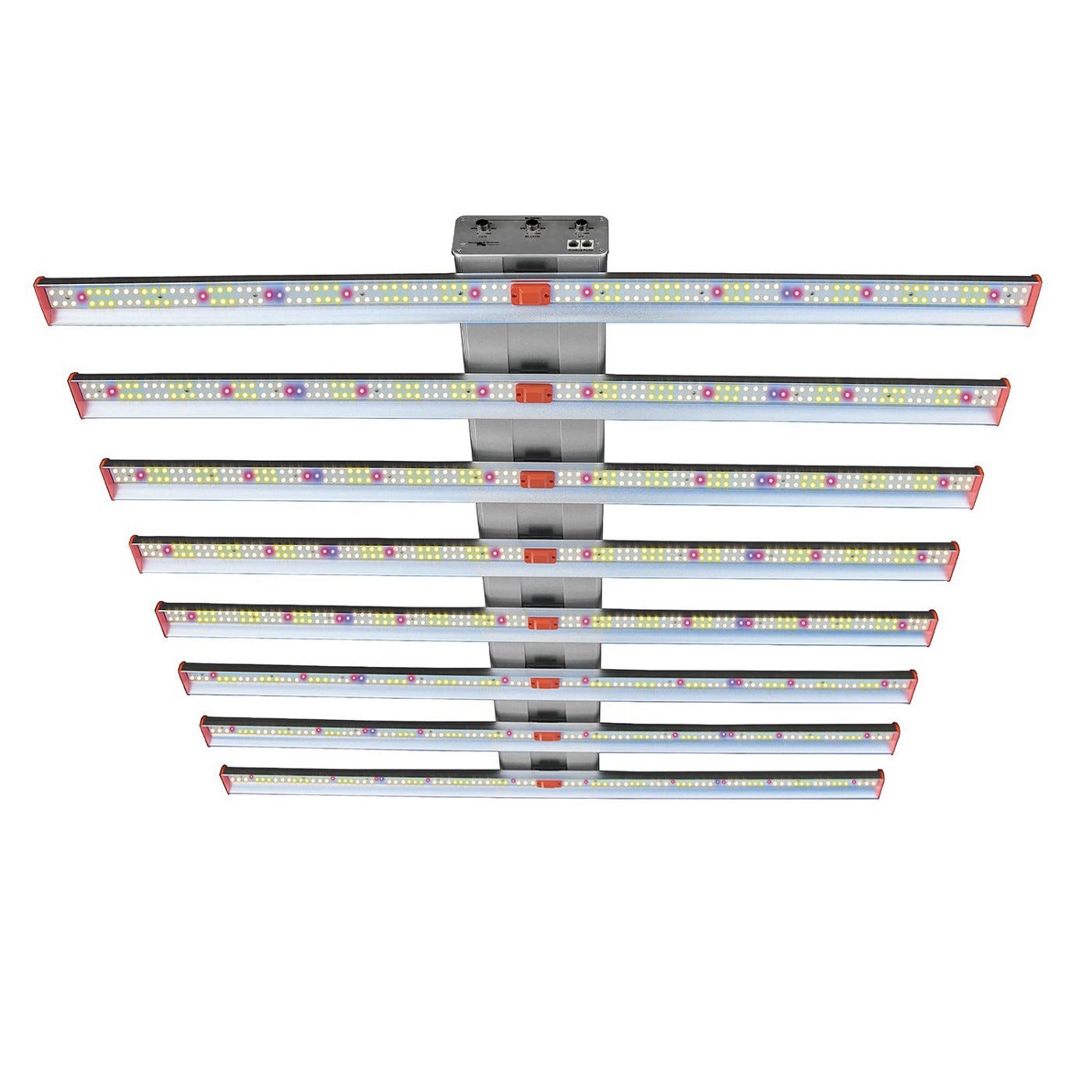
Features:
The ECO Farm grow light is equipped with Top Bing Samsung LM301H & Osam chips and brand drivers, which have higher efficiency and longer service life; and 8 high-efficiency aluminum rods to ensure high-efficiency PPE 2.7umol/J, better heat dissipation, and long service life. Compared with old plant lights, the average PPFD is increased by 30%, and the yield and quality are increased by 50%. At the same time, it also has an ideal full-spectrum and amazing heat dissipation: full-cycle Sunlike Spectrum, the results have been verified, optimized for rapid growth and complete plant development, close to natural sunlight. The spectrum applies to the entire stage of indoor planting. This ECO Farm LED grow light has 3 channels control. EG dimmer controls white light 5000K, a Bloom dimmer controls white light + red light (30 00K+660nm+ 730nm), and a UV dimmer that controls UV 395nm.
RayonLED GLMF-720W FOLDABLE LED Grow Light
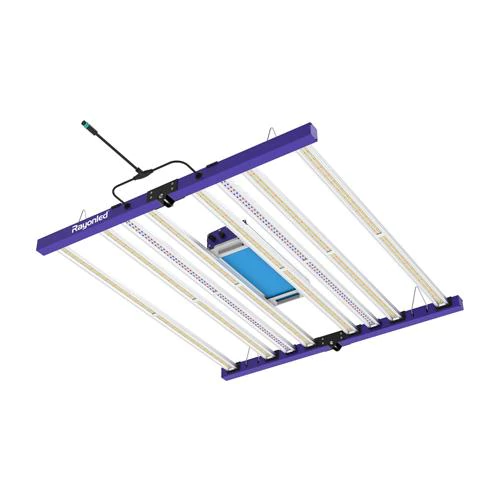
Features:
With its impressive expertise in LED technology, this medical-grade device has everything to appeal to hobby and commercial growers. The RayonLed grow light is designed to replace and surpass the results of 1000W HID fixtures. What’s more, the fixture has a dedicated UV-IR strip that can be controlled independently. From spectrum to certification, it’s engineered to compete with the top grow lights on the market. Passively cooled light bars provide full spectrum, broad coverage light for long-term growth. High output 1944 µmols PAR! and an impressive efficacy of 2.7 µmol/s per watt. The unit features UV and far-red light strips to provide the most complete spectrum on the market today! IP65 certification allows lights to function and last in even the wettest grow rooms
Fluence SPYDRx Plus 685W LED Grow Light
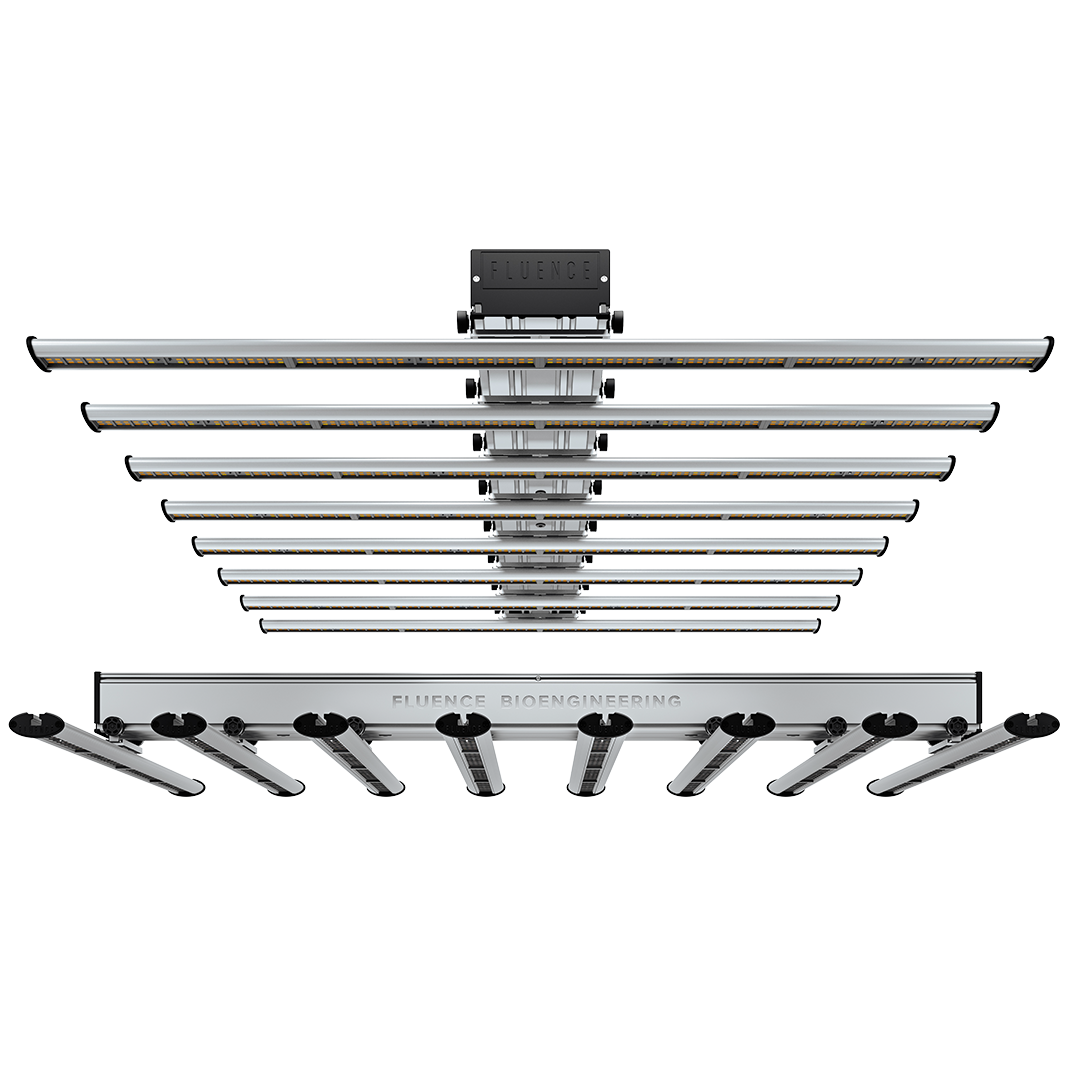
Features:
SPYDRx PLUS is a full-cycle top lighting solution for commercial horticultural planting with the ability to grow from vegetative to flowering. The SPYDR series is only 4.6" thick, with a recommended installation height of only 6" from the top of the canopy, and is designed for vertical farming — from vegetables to flowering — with an average PPFD of up to 1,030 µmol/m2/s on a 4'x4' top on the canopy. All SPYDR models can be dimmed with an optional light intensity Dimmer for precise control of the PPFD and provide flexibility to instantly adapt to new crops with varying light requirements. Recommended installation height is 6" for optimal light uniformity, penetration and flux density above a 4'x4' canopy.
Best Grow Light For Indoor Plants Buyer’s Guide
The Most Important Features to Consider
Full Spectrum Light
While a natural light source is ideal, indoor gardens can’t always get sunlight regularly. One of the primary reasons to buy a dedicated indoor plant grow light instead of using a regular incandescent or fluorescent light is that normal bulbs and household lights don’t often provide full-spectrum light, or dedicated spectrum light, both of which are essential for the healthiest, most efficient growth cycles. Dedicated grow lights should always feature full-spectrum lighting, and preferably have options for partial spectrum lighting as well, allowing you to tailor your lighting to your plants’ needs.
Energy Efficient
Typical grow light cycles can be anywhere from 12 to 18 hours- and occasionally 24 hours. That can lead to an expensive electric bill if your grow lights aren’t designed for maximum energy efficiency. Fortunately, most consumers and nearly all commercial grow lights are designed explicitly to be energy efficient, regardless of the amounts of light they use. This is also why most grow lights employ LED instead of incandescent lights- although an added benefit is that they remain cooler over long periods of use and are thus safer.
Adjustability
No two growing setups are going to be the same, so it’s important that whether you’re looking for a high-powered 1200 watt grow light or a USB-powered 60 watt model for small plants and office use, the model you chose offers some degree of adjustability. This can include features like fully adjustable goosenecks for smaller lights and adjustable tripods for floor plants, but it also includes features like multiple brightness settings, auto on/off, multiple timer modes, and even multiple lighting type modes. Fortunately, these are all common features on a wide variety of popular models.
How to Use Grow Lights
Grow lights give you the opportunity to expand the range of plants you can grow indoors. They can also help your plants grow faster or look healthier when they are located in areas that don’t get enough natural light. The best type of light source you can use is one that emits a warm color (even white can be a warm color!) and whose position can be adjusted. You don’t want your lights to be too close to your plant, so it’s nice to be able to change the distance as it grows. Most grow lights have timers that mimic the sun’s natural light. If your plants are completely out of light because of where they are placed, they should be left on for 8 to 16 hours. If you get enough light, you can vary the timing to keep your plants looking their best.
Conclusion
Care-intensive tasks like harvesting plants indoors can indeed become a very difficult task without the proper awareness and expertise. A lot can go wrong if you don’t follow the correct steps, so we hope today’s guide will help you with all of your plant harvesting needs.
3 Best 600W LED Grow Lights For Indoor Grow Tents (2023 Updated)
December 26, 2022
Do you want to grow organic vegetables and flowers at home? Or, do you want to brighten up a dull interior with some greenery? If so, then you need to invest in quality grown bulbs to create a peaceful atmosphere in your home.
These grow lights are an essential tool for successful indoor gardening. Unfortunately, buying plant growth bulbs can be challenging, as you may come across confusing jargon. But don’t let that scare you, because this list of the best grow lights 2023 will help you grow plants at home with ease.
Why grow lights matter
Along with soil and nutrients, light is key to plants’ growth and development. Like all other plants, rely on light for photosynthesis– converting light into food and energy. With enough light, plant not only grows strong and healthy; it also fuels bud production once it’s reached the flowering phase.
Grown outdoors, plant follows the environment’s changing seasons. Plant germination, growth, flowering, and reproduction are reactions to environmental changes, and light cycles ignite these reactions.
Environmental changes to consider:
Light exposure
Temperature
Humidity
All these factors affect how your plant grows and develops.
When growing plants, it’s important that they get 18 hours of light to vegetate and 12 hours to flower. You control the lighting. Outdoors, your timing for when you plant, as well as the weather, affect how much light your plant gets.
Growing indoors allows you to change and maneuver plant’s natural light cycles. Indoors, you don’t have to rely on mother nature to produce high-quality plant.
ECO Farm Z6–600 Samsung LM301B LED Grow Light
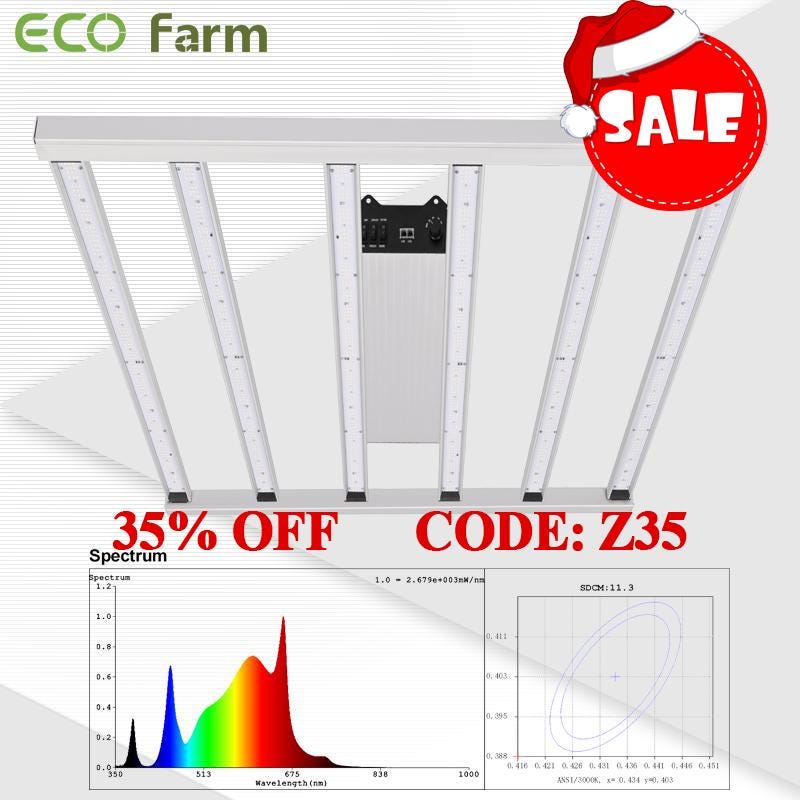
Features:
This ECO Farm LED grow light uses a high-quality and durable driver and top trash can LED generation and 6 passive cooling light bars to provide full spectrum and wide coverage light for vegetable and flowering growth stages. It covers 5'x5' Veg footprint and 4'x4' flower footprint. The high energy efficiency of 2.7umol/J produces a total PPF output of 1501 umol/J, which produces uniform light spread very close to the crop canopy, and provides excellent effects for indoor planting, greenhouses and planting tents. Compared with conventional similar wattage HPS solutions, LED lights can achieve 30–40% HVAC capacity and up to 30–60% increase in output. IP65 wet environment protection grade, waterproof and dustproof. The LED plant growth lamp adopts high-quality aluminum heat sink design to efficiently dissipate heat. It has no additional fans, and the quiet planting environment has zero noise.
OCL SKWID 1900 Pro LED 680W Grow Light
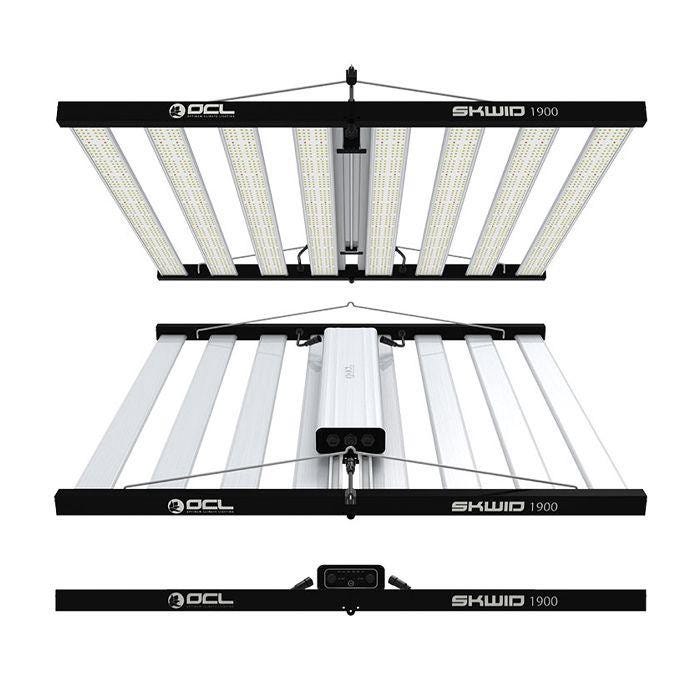
Features:
The OCL SKWID 1900 PRO LED is the next level in professional fixtures with the ability for central control with the OCL Lightning Touchscreen controller. With OCL lighting systems you are in control of the light! The OCL SKWID 1900 PRO LED grow light offers an absolute market-leading PPFup to 2070 μmol/s! The OCL SKWID 1900 PRO LED is a high-performance energy-efficient alternative to the traditional commercial 1000W DE HID fixtures. OCL SKWID 1900 PRO LED is developed for growers by growers whose cultivation is in low rooms, on vertical racks, over rolling benches, and intents. For maximum uniformity, hang the fixture 12–24 inches from the crop. The efficacy of this fixture is very impressive at 3.04 μmol per watt. At 680 watts this will lead to 2070 μmol s-1 The eight bars are passively cooled in an extra-wide shape to enhance spread and coverage. The absence of moving cooling parts reduces the possibility of mechanical failure.
Grower’s Choice ROI-E680 LED Grow Light
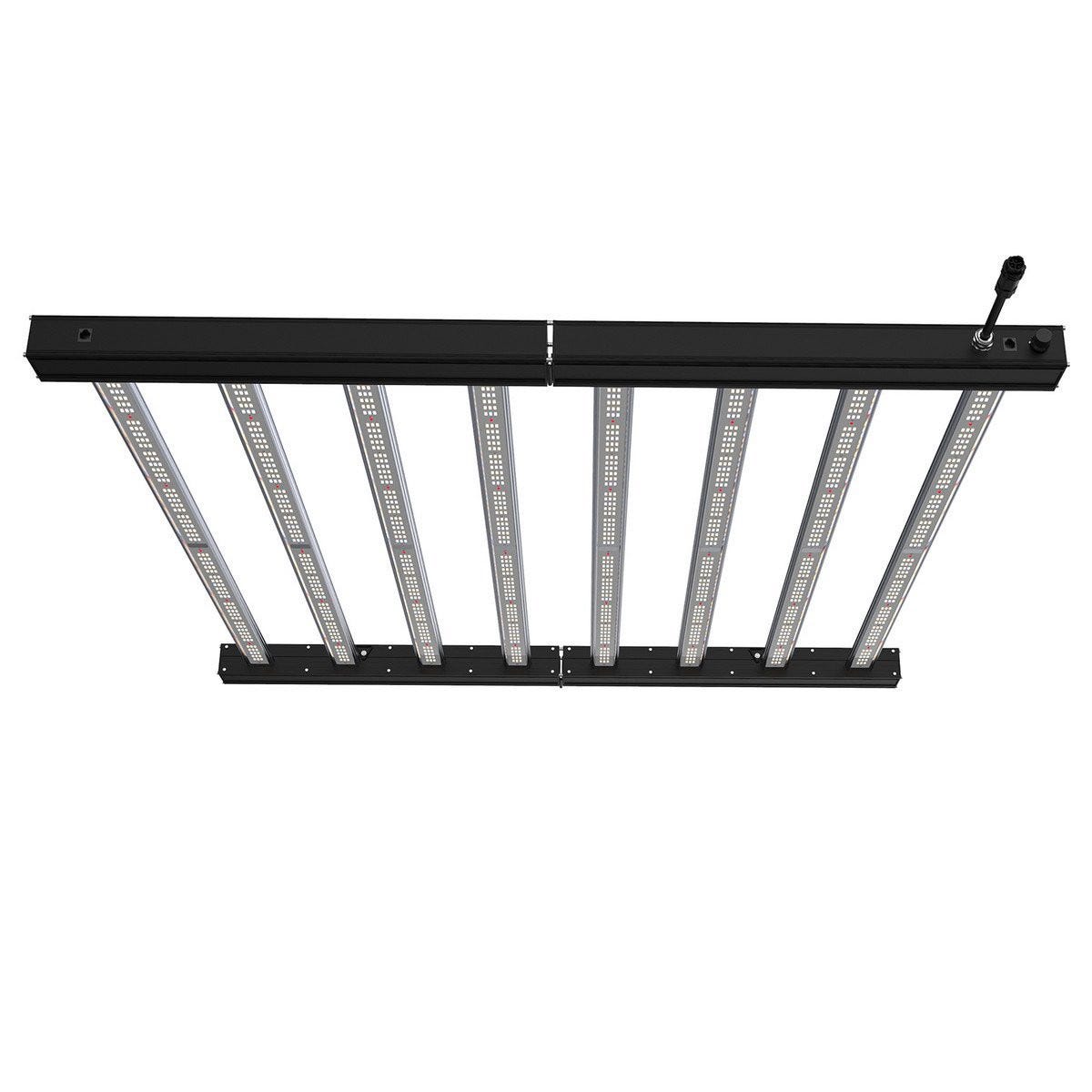
Features:
This fixture provides you with total control over everything. With onboard dimming function, growers can et the ideal intensity at any stage of plant growth for optimal photosynthesis activation. Also, it is compatible with most lighting controllers including Growers Choice Master Lighting Controller. The ROI E680 produces a PPF output of 1700 umol/s and a PAR efficacy of 2.5 umol/J making this fixture incredibly efficient compared to other commercial fixtures. The Growers Choice ROI E680 provides its users with an average 40% reduction on energy and HVAC costs. This is the ultimate combination of increasing the amount of light energy reaching your plants while also shrinking costs. The Growers Choice ROI-680 LED grow light allows for even light distribution and is precisely designed to deliver uniform levels of photosynthesis flux density, or PPFD. The specially deployed full spectrum fills the negligence of the main photoreceptors and pigments outside the 660nm and 450nm range, and it is suitable for reproduction to aging in indoor environments.
What should I consider when choosing the best lights for growing plants?
Whether you’re looking for grow lights to supplement natural light for your houseplants in winter, or you’re looking to start seeds indoors to transplant into your garden in spring, grow lights can help.
Grow lights are marked with numbers such as 2,500K or 6,500K, which tell you the temperature of the lights based on the Kelvin measurement scale. The higher the number, the cooler the light. So a bulb with a Kelvin rating of 6,000K will appear white or blue, while a bulb rated at 3,000K will appear more yellow. Each type of light — warm or cool — stimulates specific plant behaviors.
If your goal is to improve foliage growth on houseplants or to grow leafy greens or seedlings, choose a cool-spectrum bulb around 6,500K. Warm light has a lower Kelvin rating, making it ideal for houseplants and flower production for fruit trees like citrus. When in doubt, full-spectrum lights take the guesswork out and offer a combination of warm and cool light for the best of both worlds.
The electromagnetic spectrum is the extended range of wavelengths or frequencies of electromagnetic radiation. The electromagnetic spectrum is made up of the visible spectrum (the type of light we can see) and the infrared spectrum (the type we can’t see). The light time of the four seasons is different, which will affect photosynthesis. Certain colors of light are more important for photosynthesis than others. Plants are adapted to absorb and utilize the right amount of light to grow naturally outdoors.
When growing plants indoors, we must reproduce the light produced by the sun, keeping in mind two important factors: color temperature and duration. The temperature of colors on the electromagnetic spectrum is measured in Kelvin.
Unlike the bulbs in chandeliers or wall sconces, grow lights emit a spectrum similar to the sun.
Grow lights emit less heat than traditional light sources, so they are less likely to burn your plants
You can use grow lights to start seeds indoors before spring, care for outdoor plants that have been moved indoors for the winter, or grow plants indoors year-round. They also serve as replacement windows for those who live in darker homes and need some help keeping sun-loving houseplants alive.
Plants grow best in light as close to natural sunlight as possible, at temperatures between 2,700 and 7,000 Kelvin. In the past, growers used red and blue LEDs to provide plants with the full-spectrum light they needed to grow. The only reason to use red and blue LEDs is that white LEDs that provide the necessary spectrum and brightness do not yet exist. However, with new technology, it is entirely possible to get the full spectrum and brightness that plants need, 2,700 to 6,500 Kelvin and white LED lights. White LEDs use the least amount of power, last the longest, and can grow plants like all other types of lights available today.
Conclusion
These days, we generally recommend LED grow lights for just about everyone. Fluorescent lights make a lot of sense for growing smaller plants that don’t flower or for dedicated seeding, cloning, or vegetable growing spaces.
HID lights no longer have any real advantage over LEDs. One exception is CMH. These bulbs are comparable to premium LED fixtures in terms of efficiency and light spectrum, but LEDs (of course premium fixtures) are still better. However, CMHs are usually less expensive.
Best 700W LED Grow Lights of 2023: Complete Reviews
December 24, 2022
Looking for the best LED grow lights for your indoor growing projects? Researching this topic can be overwhelming, leaving you more confused than you started. Grow light specifications can quickly become technical, telling you how many watts, lumens, PAR or PPFD your grow light can deliver.
Once you know the basic grow light metrics, you’ll feel more comfortable choosing the best lights for your vegetable garden, or small grow lights for houseplants; the opportunities for indoor gardening are endless.
What Makes the Best LED Grow Lights?
The best LED grow lights have several things in common — uniform light spectrum, efficiency, high power and reliability/durability.
Spectrum/Uniformity
The best LED grow lights have a uniform spectrum, so if you have 4 plants under your light, they will all get the same spectrum.
We’ve touched on the spectrum a bit, but it’s important to reiterate that the best spectra include not only red and blue light, but also infrared (IR) and ultraviolet (UV).
Full-spectrum LEDs allow you to use the same light from seed to harvest instead of having to change bulbs or use different grow lights to grow vegetables/flowers.
Strength
The more light the LEDs actually emit, the more yield you’ll get (in most cases). Therefore, the best LED grow lights need to be very powerful.
Efficiency
Generally speaking, LED grow lights are very efficient. However, the best LED grow lights are also often the most efficient. It is very important to operate at a high level, generate high power, and keep it low cost.
Reliability/Durability
Given the cost of LED grow lights, they need to be considered an investment. Obviously, your investment needs to last a long time to show returns.
Therefore, the best LED grow lights are reliable and durable to stand the test of time.
All the lights we will list are from the most reputable brands and include some kind of warranty. This will give you peace of mind when purchasing knowing you are protected.
ECO Farm ECO D700 700W Samsung LM281B Chip LED Grow Light
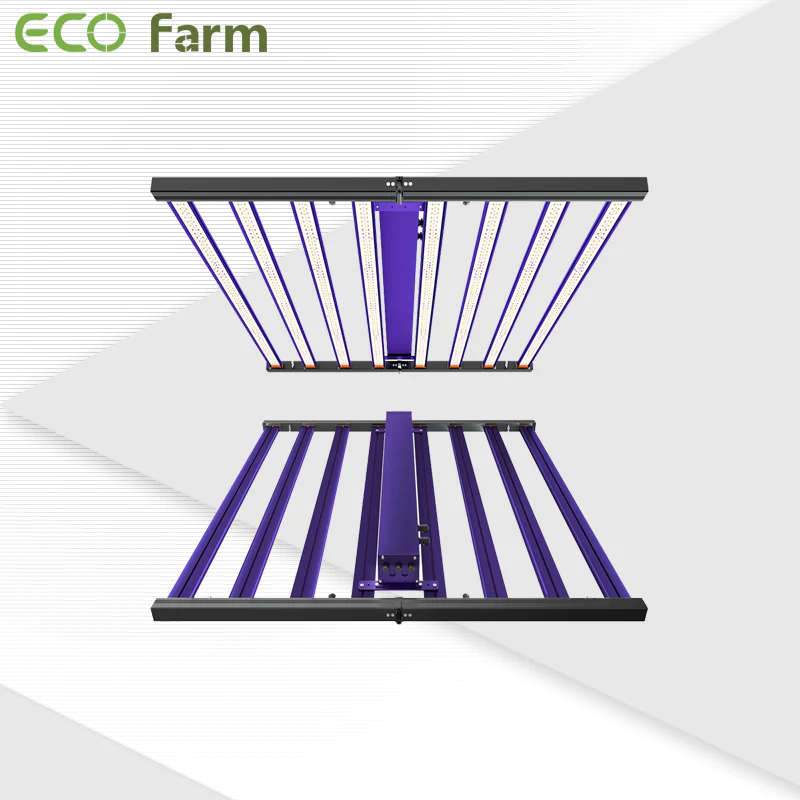
Features:
This ECO Farm LED grow light has the highest output of white chip and Osram chip, with high energy efficiency of 2.6 umol/J, PPF 1820 µmol/s, LED grow light provides plants with powerful and high quality light to maximize the Yield. The vegetable footprint is 5 x 5 feet and the flowering footprint is 4 x 4 feet. With an excellent full spectrum (3000K, 5000K, 660nm, 730nm IR, 395nm UV), it can make the light more uniform, truly simulate sunlight, and perfectly meet the entire growth cycle of all plants from seed to harvest, resulting in higher yields. The dimming knob can adjust the light intensity at will (from 0% to 100%), and the daisy chain can be up to 100 units, which easily meets the plant development process, including germination, nutrition, flowering, and fruiting. Foldable for easy placement and portable installation, the adjustable adapter has an RJ45 interface, which can control multiple plant lights in series, which is convenient for you to plant in a large area.
Maxibright JUNO PRO — 720W LED Grow Light
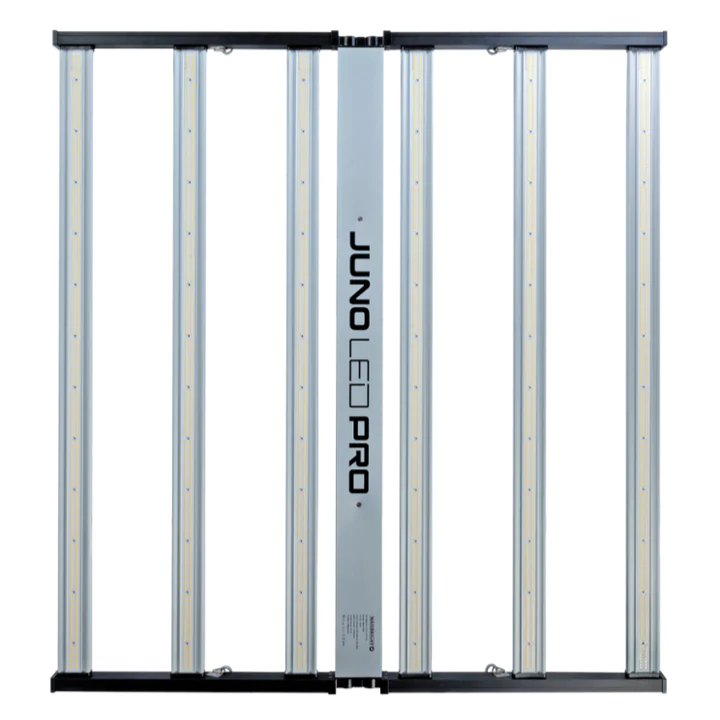
Features:
The Maxibright LED Grow Light is an affordable and powerful 720 watts, has an output of 1800 micromoles per second (PPF), and is optimized to cover an area of 1.5 m x 1.5 m. 6 LED strips to provide uniform full spectrum light with added red spectrum for enhanced blooming. The whole luminaire folds in half, is very easy to transport, and unlike other LED units on the market, it is truly plug-and-play and requires zero assemblies of any kind. At only 40mm high, it maximizes the usable height in any growing space. Juno uses all-new MaxiLED chips. These high-quality chips are hand-picked by Maxirow and will provide the perfect spectral output for high-yielding plants. Each unit comes with a remote dimmer that allows you to adjust the light from 25% — 50% — 75% — 100% power. This is especially useful for growing young plants that don’t require as much light as more mature flowering plants.
Lumii Black 720W LED Grow Light
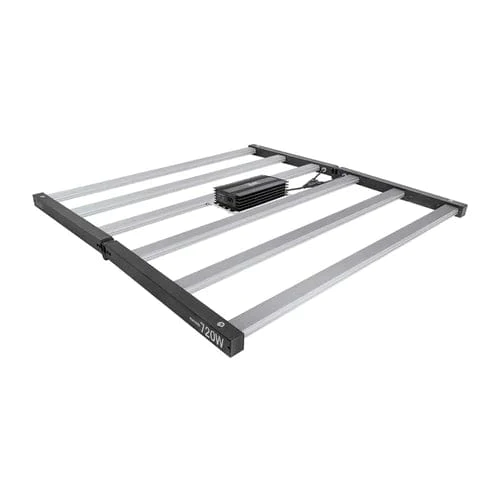
Features:
This 720W rated Lumii LED grow light is an excellent choice for stimulating your space to flourish. To power the lamp, you will need the LUMii Black 600W digital ballast sold separately. This is the same ballast used for the LUMii Black HPS kit. These lights are lightweight and easy to install, and with the LUMii cord ratchet, you can adjust the fixtures’ height according to the canopy’s height. Just plug in, adjust the height, choose your output settings, and relax.
What To Look For in a Good Grow Light
Before selecting a particular grow light, you must carefully examine the following characteristics:
Power
It is crucial that your grow light is energy-efficient so that you can avoid paying high electricity bills. Grow lights with a lower output wattage are cheaper to operate and don’t generate a lot of heat that could burn your plant. Keep in mind that the higher the wattage is, the hotter the grow light will get, and the more energy it will consume.
Full-spectrum
To support the growth of plants in an indoor environment it is essential to ensure that the grow light you get is capable of outputting a full spectrum of light, as this will mimic the natural light of the sun. With that said, full-spectrum LEDs are more expensive, but they do provide a full spectrum of light for optimal growth in all stages of a plant’s life.
Temperature
The temperature of your grow light is crucial, as it will directly affect your indoor plants. You will want to choose a grow light that doesn’t emit more heat than natural light. We suggest white or yellow lights for smaller plant installations in your home. Red lights may be more optimal for growing fruits in the home, as these provide the heat needed to promote the growth of more sturdy plants.
Conclusion
LED grow lights have become very popular as an effective way to provide light to plants to help them grow. These lamps provide specific light and heat to the plants, promoting their growth. The best LED grow lights can be expensive and take some getting used to. But the people who invest in them, swear by them.
2023 Best 700W LED Grow Lights for Indoor Gardening
December 16, 2022
More and more growers are adopting LED grow lights as the preferred light source for grow tents. These lights come in different sizes and models to meet the specific needs of growers. However, growers are often faced with the tricky decision of choosing the right LED grow light that best meets their plant lighting requirements.
Why is light important to plants?
Even shade-loving species need some light to grow lush and leafy. Without it, plants cannot produce the chemical energy necessary to produce the nutrients needed for healthy growth, flowering and seed production.
This plant-specific process, called photosynthesis, occurs when energy from sunlight converts carbon dioxide and water into carbohydrates. Insufficient light for houseplants can cause these energy stores to deplete, and eventually, your plants won’t be able to save.
ECO Farm MB3 Pro 760W LM301B LED Grow Light
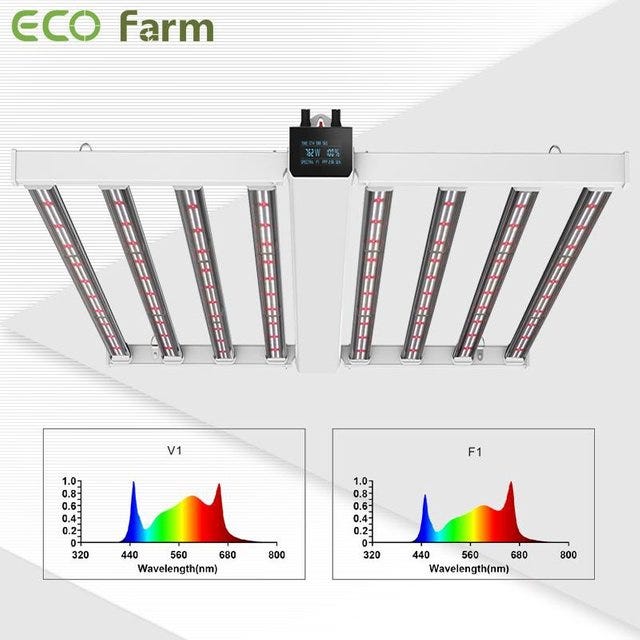
Features:
High efficiency + high yield ECO Farm LED grow light is equipped with tWith 2880 pcs SAMSUNG LM301B diodes+80 Osram 660nm, with high PAR/PPF efficiency up to 2.8 umol/J and powerful output, enabling you to Obtain higher output. Only consumes 760W. The ultra-thin and unique 180° foldable design grow light is easy to stretch or fold. It is very suitable for large-area planting and commercial planting. The perfect coverage area is 4*6 feet. Both sides can be folded freely from 0° to 180°, easy to install, save space, and easy to carry, no need to worry about hurting hands and lights. The dimming knob is ideal for growers to adjust the light intensity according to different growing stages., which provides the needs of each stage of the plant, allows the plant to obtain the perfect growth effect flexibly, increase the yield, and save energy costs at the same time.
Lumii Black 720W LED Grow Light

Features:
This 720W rated Lumii LED grow light is an excellent choice for stimulating your space to flourish. To power the lamp, you will need the LUMii Black 600W digital ballast sold separately. This is the same ballast used for the LUMii Black HPS kit. These lights are lightweight and easy to install, and with the LUMii cord ratchet, you can adjust the fixtures’ height according to the canopy’s height. Just plug in, adjust the height, choose your output settings, and relax

Features:
Kind LED grow light uses top-of-the-line Osram and Phillips diodes to produce targeted full-spectrum light as well as UV and IR to enhance your plants during flowering. The KIND X750 uses the full spectrum white LED diodes used by top LED companies. Kind’s Targeted Full Spectrum is designed for plants to maximize harvest weight and plant quality. Our spectrum is the result of hundreds of thousands of hours of field testing in the Northern California medicinal plant industry. With 750 watts of power and a 4' x 4' footprint, the X750 is powerful enough for commercial growers while still being compact enough for single planting.
What should be paid attention to when choosing high-quality plant growth lights?
Premium build and materials
Durability is one of the most important things about LED bulbs for indoor plant production. If your lights are designed with the highest quality materials i.e. PVC, metal, aluminum etc. then the lights will last 10 years or more so you don’t have to worry about installing them in your living space.
Brand reputation
The most difficult task is to choose the best brand to buy your product. However, considering that not all options are of the same quality, all brands have their own specifications.
When you find that all brands of LED lights are the same in price and appearance, you should go after brand reputation. View customer reviews, long history and company research to make your decision easier
High quality semiconductor chip
The role of the semiconductor chip is to convert electrical energy into light energy, and it also plays an important role in determining the wavelength. For adequate lighting, we recommend looking for lamps with a chip power of at least 3 watts.
Conclusion
Plants cannot survive without light. Outdoor plants get their light from the sun, while indoor plants rely on artificial light sources, including LED grow lights. LED grow lights offer more lighting options and features, and are cost-effective for a long time. Once you have determined how many watts of LED lights you need for your growing area, you can purchase LED grow lights, or a combination of LED grow lights that provide this output.
How to Choose the Best 1000W LED Grow Lights for Indoor Plants? (2023 Updated)
December 12, 2022
If you’re planning to grow your own vegetables indoors for the first time, the prospect itself can feel pretty scary just thinking about it.
Not only do you have to think about fertilizing, but you have to be strict about your grow lights and your watering and harvesting schedules.
But let us help you with all your plant harvesting worries today with our comprehensive guide, covering not only the various types of indoor grow lights, but the different steps involved in harvesting.
So, sit back and read on.
What does the LED light do?
LED grow Light is an emerging technology that aims to replace HID in agriculture. The latest generation of LED systems may produce plant quality comparable to normal HID systems, and in some cases higher. PAR, or photosynthetically active radiation, is the parameter most valued by LED extremists.
LED grow light technology has made remarkable progress in the past year. While almost any LED grow light (even the poorest ones) can be used to grow quality plants, newer versions designed for plants offer higher yields, plant densities, and development rates than earlier and more versatile models.
How to use plant growth lights
There are several ways to set up grow lights, but the most common way is to hang the grow lights above the plants.
Dedicated grow light fixtures, such as fluorescent and LED lights, are designed to accommodate specialized bulbs. While these dedicated grow lights are convenient, some of them don’t actually emit the full spectrum, so be careful when choosing grow lights. They have great coverage and often have their own built-in cooling system, making them ideal for large indoor gardens or large houseplants.
There are also grow bulbs made specifically for traditional light fixtures. This allows you to use full-spectrum bulbs or fluorescent bulbs in existing lamps or fixtures. This grow light is perfect for small indoor gardens or plants that don’t require a lot of light.
ECO Farm ECO NET 1000W Samsung 301B Chips LED Grow Light
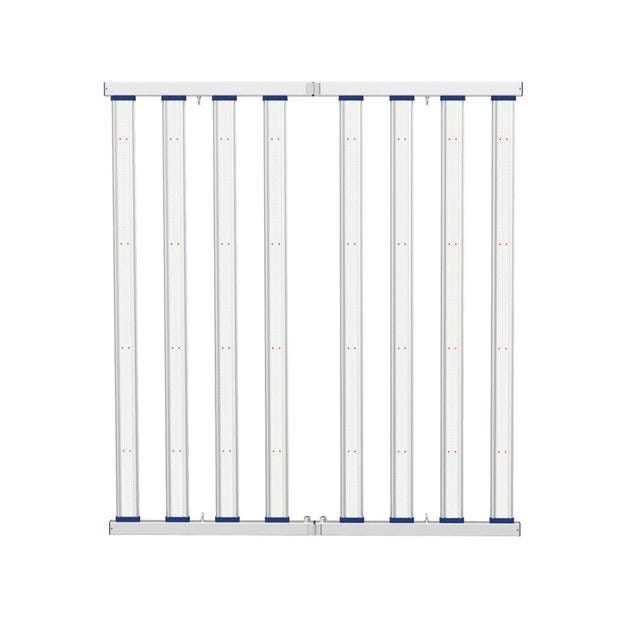
Features:
This ECO Farm LED grow light’s cover the full-color spectrum 3000K 5000K 660nm our grow lights are ideal for all growth stages. Perfect for indoor, greenhouse planting, personal and commercial growth. This grow light is designed for the full plant life cycle. The light intensity can be adjusted by the knob. The sun-like light is best for indoor hydroponics and soil cultivation, such as potatoes, peppers, tomatoes, etc. The SMD LEDs used in this LED grow light are professionally customized and produced with the latest technology. Higher light intensity, lower speed of light decay, and higher PAR values than ordinary lamp beads. It provides 2.7μmol/J high efficacy output plant light. Maximize yield and optimal quality. Saving up to 50% energy and 30% cooler than other grow lamps. The latest aluminium radiator has a special surface treatment that doubles the heat dissipation area. IP65 Waterproof. High power, low heat, and low failure rate grow lamp.
Iluminar 1000W iLogic™9 Full Spectrum LED Grow Light
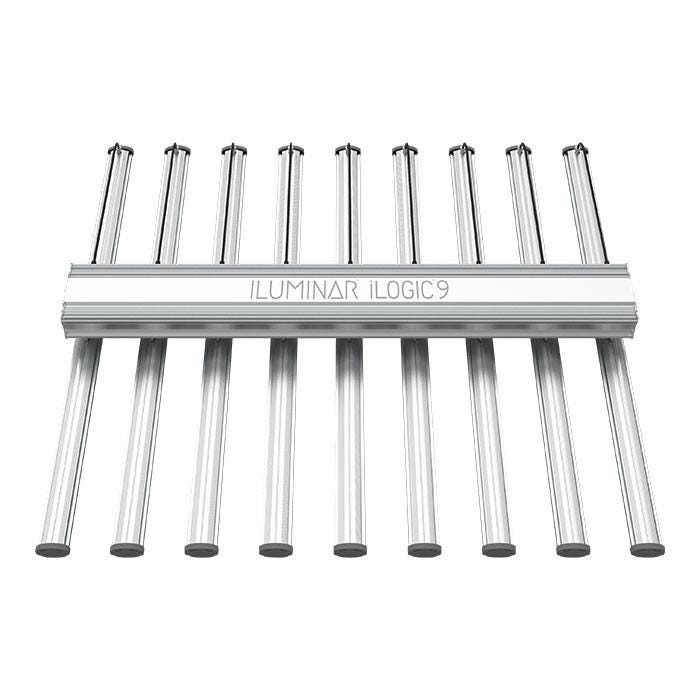
Features:
The Iluminar Grow Light is the go-to high-efficiency lighting fixture for sealed grow rooms enhanced with CO2 supplementation. Nine light bars deliver extremely high light intensity and uniformity across a 4’ x 4’ footprint to drive unbeatable growth rates and flower production. Delivering an incredible 2800 μmol/s PPF, the iLogic™9 Full Spectrum fixture has the power to penetrate more deeply into the densest indoor plantations, giving lower growth tips the intensity they need to reach the canopy, resulting in more viable flower sites per plant. Cultivators enjoy bigger yields, higher quality, and more overall crop homogeneity. The enhanced canopy penetration frees growers from the chore of remedial foliage stripping in order to promote the development of lower and mid-tier flower sites.
Spectrum King Phoenix 1050W LED Grow Light
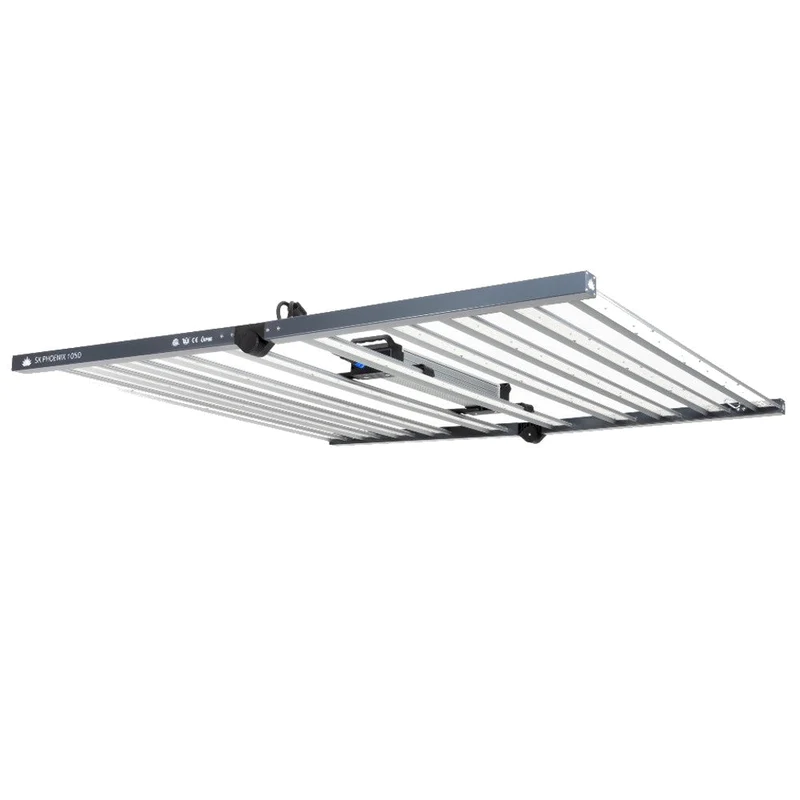
Features:
Spectrum King’s Phoenix 1050W LED Grow Light is a grow lighting beast that unleashes 1050 watts of sun-like light in areas up to 6' x 6', unleashing the ultimate output for your grows. Designed to hang high, the Phoenix 1050 recreates the sunniest summer days for plants that never seem to get enough light. SK Cryo-Therm cooling technology enables an ultra-thin profile that allows maximum airflow and minimizes microclimates. Optimized for single or multi-tier planting near the canopy. For growers who need the biggest, brightest LEDs, the Phoenix 1050W is for you.
How to Choose the Best Grow Lights for Indoor Plants?
Along with great fertilizers for indoor plants, indoor grow lights can be extremely beneficial for your plants’ growth. When choosing the best products for your plants, always consider the following factors:
Your Needs
Your specific needs will dictate your choice of product. Whether you’re taking care of inexpensive indoor plants or rare ones, researching their light requirements and needs should be your first step in finding the best light for growing plants indoors.
Free Space
Many grow lights are highly portable and easy to install, but some require bigger spaces. Choose a product that’s suitable for your indoor space and that won’t hamper your day-to-day living as you help your plant grow.
Type of Light
Although many grow lights emit a full-spectrum light perfect for any stage of plant growth, some specialize in specific stages, such as flowering or seeding. Make sure the product offers the right type of light for your indoor plant to grow properly. For instance, you don’t want high-intensity to grow lights for low-light indoor plants.
Ease of Setup
The best grow lights for indoor plants are the ones that are easy to install and operate. Depending on the plant size, many of them are hanging lamps or standing on a tripod. Before buying anything, make sure you understand how to correctly install the lights — remember that you’ll also be dealing with electricity, and incorrect installation can be hazardous, especially if you’re a beginner indoor plant grower.
Your Budget
Your budget will also affect your choice of product. Remember that while choosing the best grow light is important, it also shouldn’t break the bank.
Wattage
You don’t want a product that consumes too much electricity while providing mediocre results. Check the wattage of the device before purchasing and go for products that offer high-efficiency lighting.
Light Color and Design
Plants respond to red, blue, and warm indoor plant light in a variety of ways, so make sure the product’s design and light colors are suitable for your indoor plant.
Customer Reviews
Finally, check the product’s reputation with customers who’ve used it firsthand. Pay attention to what they highlight in terms of brightness, energy consumption, and effectiveness in helping plants grow, while taking note of the common complaints they have about the product.
Conclusion
When using indoor grow lights, simply consider how natural light works and what your plants have evolved to expect from it. You can even use this knowledge to control plant growth, such as adjusting the light to encourage flowering plants to bloom, or keeping the light on for 24 hours to speed seedling growth. If you’re more interested in home aesthetics, a simple incandescent bulb in a stylish table lamp like this one will do wonders for your houseplants (especially those in dark corners where not much natural light comes in) . Growing plants indoors is a lot more fun when your plants are thriving, so have fun!
How To Choose the Best 700W Indoor LED Grow Lights? (2023 Updated)
December 10, 2022
If you’re looking for a LED grow light to start your indoor garden, you’ve come to the right place. There are many quality products from various brands on the market today. However, not all of these provide the same functions and benefits to your plants, depending on their intended use. That’s why it’s important to do your research before choosing a particular model. In this article, we discuss the best LED grow lights and what makes them special. We’ll also provide some helpful tips to help you choose the right product for your needs. After reading this guide, you should have a good understanding of how each product is different and which one is best for your needs.
What spectrum do you need for LED grow lights?
Sunlight is, without a doubt, the most all-inclusive spectrum when it comes to growing plants. That said, LED grow lights act as imitators to allow plants to grow in various conditions. These grow lights essentially imitate sunlight exposure for optimum plant growth.
The following spectrums are needed to grow different plants using LED grow lights:
– Seeding: The optical density is low in the seedling period. Hence, the primary spectrum needed during this period is blue light.
– Leafy vegetables: They demand a white light and blue light of 4000K.
– Flowers: They primarily need more red light with a lightning optical density PPFD of about 600 μmol/s/m2.
– Commercial plants: The spectrum for commercial plants varies according to their purpose and growing environment. In basements, garages, and all places without natural lightning, the general spectrum used is the indoor spectrum. The spectral components usually consist of red light with an optical density PPFD of 800umol/s/m2 or more.
– Fruits: The lightning optical density of fruit plants must be 800umol/s/m2 with a blue and the red light ratio of 1:4–1:6. Moreover, the color temperature must be below 4000K.
ECO Farm ECO D700 700W Samsung LM281B Chip LED Grow Light

Features:
This ECO Farm LED grow light has the highest output of white chip and Osram chip, with high energy efficiency of 2.6 umol/J, PPF 1820 µmol/s, LED grow light provides plants with powerful and high quality light to maximize the Yield. The vegetable footprint is 5 x 5 feet and the flowering footprint is 4 x 4 feet. With an excellent full spectrum (3000K, 5000K, 660nm, 730nm IR, 395nm UV), it can make the light more uniform, truly simulate sunlight, and perfectly meet the entire growth cycle of all plants from seed to harvest, resulting in higher yields. The dimming knob can adjust the light intensity at will (from 0% to 100%), and the daisy chain can be up to 100 units, which easily meets the plant development process, including germination, nutrition, flowering, and fruiting. Foldable for easy placement and portable installation, the adjustable adapter has an RJ45 interface, which can control multiple plant lights in series, which is convenient for you to plant in a large area.
HEO 1700Pro 700 Watt LED Grow Light

Features:
The HEO 1700Pro 700 Watt LED Grow Light is an excellent light for any and all phases of a plant growing lifecycle, whether you’re using it in a tent for your personal indoor garden or chained together in a large commercial operation. The 1700 Pro’s 8 powerful lighting bars focus their intense light evenly across your plant canopy for healthy, potent, high-yielding plants. The HEO 1700Pro 700 Watt LED Grow Light delivers full-spectrum light to a 4'x 4'area for flowering and a 5'x 5'area for veg. The high efficacy of 2.4 µmol/j and up to 630–700 wattage power consumption make this a productive and affordable indoor grow lighting solution.
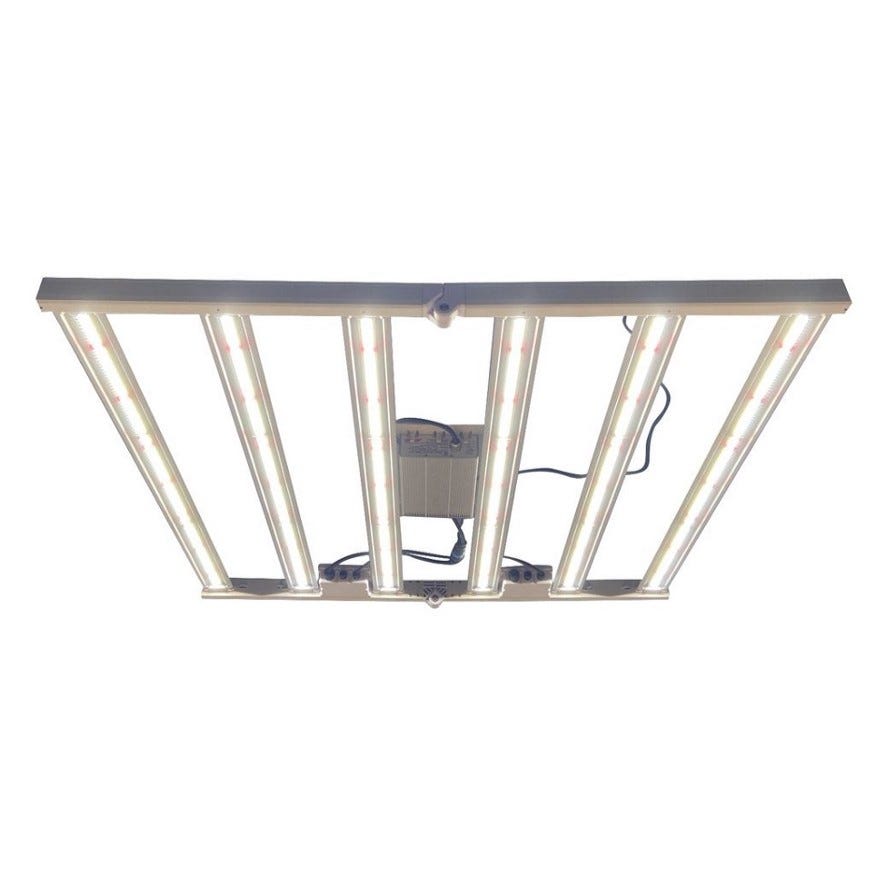
Features:
The Cultilux 700W LED grow light consumes 700 watts of real power, the total photosynthetic photon flux (PPF) output is 1820 μmol/s, and the efficiency is 2.6 μmol/J. It has reliable, high-performance light sources, including Samsung 3000K and 5000K white LEDs and Osram red and deep red LEDs. The portable 1–10V DC dimmable driver can be used with popular controllers. Designed for all stages of plant growth, Cultilux 700 provides 700 watts of power for your indoor grow space. Cultilux 700 is used in conjunction with other drivers to make this plant grow light easier to integrate with your existing plant grow light system. There is no need to worry about durability because the Cultilux 700’s aluminium and glass lens housing has an IP65 degree of protection. It has also passed UL 1598 and CE certification, making this grow light meet strict benchmarks.
Things to look for when choosing the best lights for indoor growing
When it comes to growing plants indoors, you need to have the right kind of light. Not all lights are created equal, and not all plants respond well to the same type of light. So how do you choose the best lights for indoor growing? Here are six things to look for:
1. The type of bulb. There are many different types of bulbs available, so you need to choose one that is compatible with your plants. Some bulbs are specifically designed for growing plants, while others are not. Make sure you get a bulb that is meant for growing plants if you want your plants to thrive.
2. The wattage. Higher-wattage bulbs will produce more light and thus, give your plants more energy. However, you don’t want to get too high of wattage as this can leave your plants vulnerable to burning out. Make sure you get the right wattage for the type of plant you are growing.
3. The color temperature. Different colors provide different types of light which can affect how well your plants grow. Cooler temperatures tend to promote vegetative growth while warmer temperatures tend to promote flowering and fruiting growth. Be sure to choose a bulb with the right color temperature for the type of plant you are growing.
4. Light dispersion pattern. You need to make sure that the light is dispersed evenly throughout your growing space. If some parts of the space are too dark or too bright, this can lead to stunted growth in your plants.
5. Durability. Not all lights are built to last, so it’s important to look for one that has a good warranty and is made with high-quality components. This will save you money in the long run as you won’t have to replace bulbs as often.
6. Cost efficiency. Last but not least, consider the cost-efficiency of your lighting setup when choosing the best lights for indoor growing. Consider how much electricity you will be using and whether there are any energy-saving features available on the bulb you choose. Energy-efficient bulbs can save you a lot of money in the long run.
Conclusion
Overall, there are many things to consider when choosing the best lights for indoor growing. Make sure to look for the type of bulb, its wattage, color temperature, light dispersion pattern, durability, and cost-efficiency before making your final decision. With these six tips in mind, you should be able to find the perfect lighting solution for your plants. Good luck!
A Beginner's Guide On How To Choose the Small LED Grow Lights of 2023
December 08, 2022
Indoor grow lights can have a major impact on the health of your plants. Because plants aren’t always exposed to sunlight when they’re indoors, these lights are a great alternative to the natural sunlight that keeps plants happy. Read on to find the best LED grow lights for your houseplants!
Why choose LED grow lights
LED plant growth lights gradually become a trend of indoor plant growth. It is becoming more and more welcomed by the growers. Its efficient, energy saving, and long life are the reasons why the growers choose LED. Compared with HID plant growth lights, the electricity cost of LED plant growth lights is lower, which helps growers save a lot of funds. LED plant growth lights are more environmentally friendly than traditional plant growth lights. The LED plant growth lights can be completely recycled and are environmentally friendly alternatives of HID lights. HID contains a considerable amount of mercury, which is very harmful to the environment -especially when burning. On the other hand, LED plant lights do not contain these harmful substances, which means that the air around you and your lights will not be damaged.
Easy installation is another feature. The “integrated” design of LED plant growth lights makes it easier to install. Most LED plant growth lights are plug -in and players, and there is no need to install ballasts, suspension reflectors, etc.
Although the purchase of LED plant growth lights seems to be an expensive investment at first glance, in the long run, buying the appropriate LED plant growth light will save you a lot of money. And they have a small impact on the environment and energy costs -they also provide all the light required for healthy growth for your indoor plants.
ECO Farm ECOZ 250W Samsung 301H Chips LED Grow Light
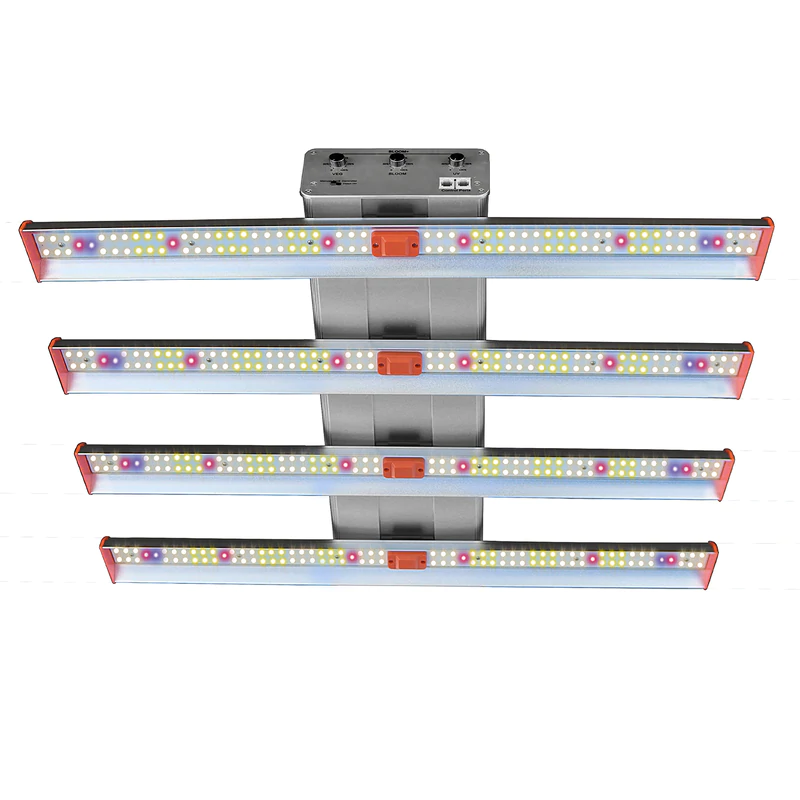
Features:
The ECO Farm grow light is equipped with Top Bing Samsung LM301H & Osam chips and brand drivers to ensure high-efficiency PPE 2.75umol/J, better heat dissipation, and long service life. Compared with old plant lights, the average PPFD is increased by 30%, and the yield and quality are increased by 50%. This plant growth light also uses a special dimmer, which can precisely adjust the brightness. 0–10 levels are optional. This means that you can see clear brightness levels and record while adjusting. No need to worry about differences. At the same time, it also has an ideal full-spectrum and amazing heat dissipation Sunlike Spectrum. The results have been verified and optimized for rapid growth and complete plant development; close to natural sunlight. The spectrum applies to the entire stage of indoor planting.
Viparspectra KS2500 250W LED Grow Light
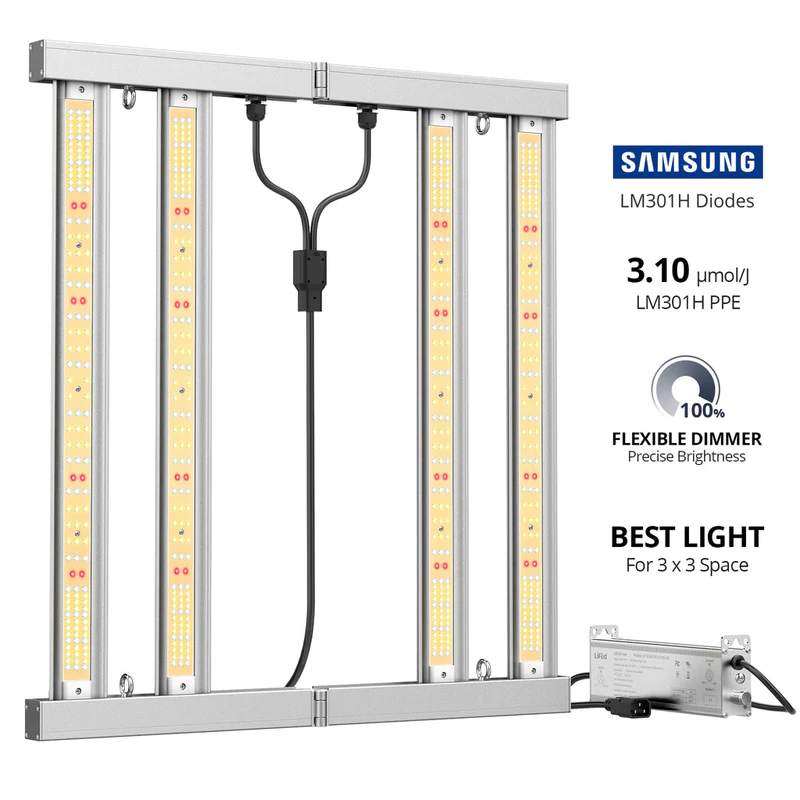
Features:
The VIPARSPECTRA KS2500 LED Grow Light uses the market leading Samsung LM301H diode (3.10 μmol/J), a more energy efficient LED that increases crop yield and saves operating costs. The KS series is designed for individual or commercial growers who want to optimize their growing space for maximum crop yield while producing the highest quality crops. Composed of 3000K warm white, 5000K white, 660nm deep red and IR730nm, it provides your plants with an excellent spectrum, tailored for germination, vegetative and flowering applications in indoor environments. The KS2500 delivers high light output and consistent uniformity with market-leading efficacy, consuming only 250 watts of perfect light for 3'x3' coverage.
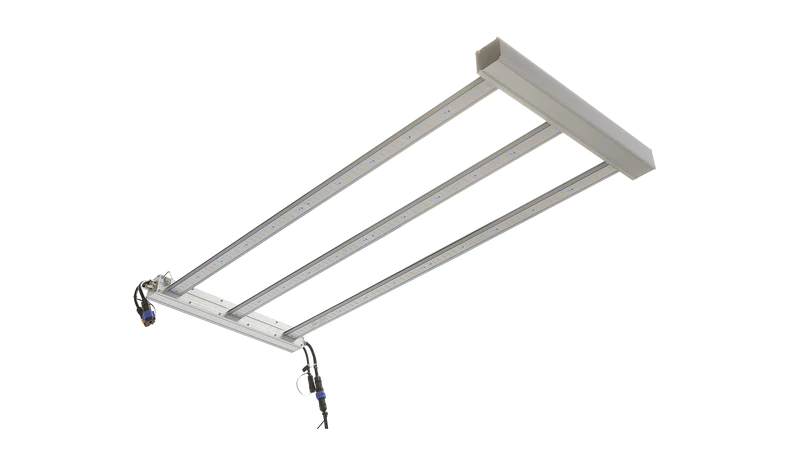
Features:
The GROWTECHX 240 of Cultivate Tech is a 240 -watt full -cycle LED plant growth light, which aims to thrive the spectral part of the growing growth of plants in the nutritional cycle and flowering cycle. The power of Growtechx240 is 240 TRUE LED Watt, which is equivalent to about 450 HPS or metal halide Watt, which means that its operating power is almost half of the traditional plant growth light. The important thing is that all fixed devices in the GrowtechX series have ETL labels, which means that they have comprehensively tested and met the North American security standards, and provided 5 years of warranty for free.
Buyer’s Guide
When you decide to buy LED grow lights, you should consider many things, maybe you don’t know what these factors are, so I will tell you some information that you should know before making a decision.
Actual Power Consumption — This is how much power your light actually draws from the wall. It’s important to consider this as it can affect your electricity bill.
Combined LED Wattage — This is the total power your light can produce and it is calculated based on the wattage and number of LEDs in the light, so if your light has 50 LEDs of 3 watts the total power will be 50 x 3 so 150 watts.
You should take this into consideration when deciding what lights to buy, and it’s usually the best LED lights for the money you have available. But keep in mind that more lights you buy means more light produced, and more light means more growth.
Conclusion
Whether you’re just getting started with indoor gardening or you’re looking for an upgrade to your current setup, one of the grow lights we’ve featured in this review is sure to meet your needs. Don’t miss out on all the benefits of growing your own plants, grow your own grow lights and start enjoying the best plants!
Best LED Grow Lights for 3×3 Grow Tents (2023 Updated)
December 06, 2022
Over the years, lists of the best LED grow lights for 3×3 tents have changed as new technologies emerged, pushing older technology out of its current place. So in this guide I’m going to round up the best LED grow lights for your 3×3 tent!
I will give you more information about this LED grow light, especially in the second half of this guide.
For everyone’s benefit, this guide is dedicated to helping you not only improve your indoor grower plants, but also help you save money!
What size grow lights do I need for a 3×3 tent?
A grow light that draws 200 to 300W high-efficiency LEDs will be the perfect LED grow light for a 3x3ft or 1x1m plant growing area.
How many plants can grow in a 3×3 tent?
Now that you have a good idea of the recommended number of LED grow lights you need for your 3×3 tent, do you know how many plants you can grow in it? The recommendation for a 3×3 tent is a maximum of 9 plants in the vegetation.
ECO Farm FLD 320W Full Spectrum Dimmable LED Grow Lights Bar
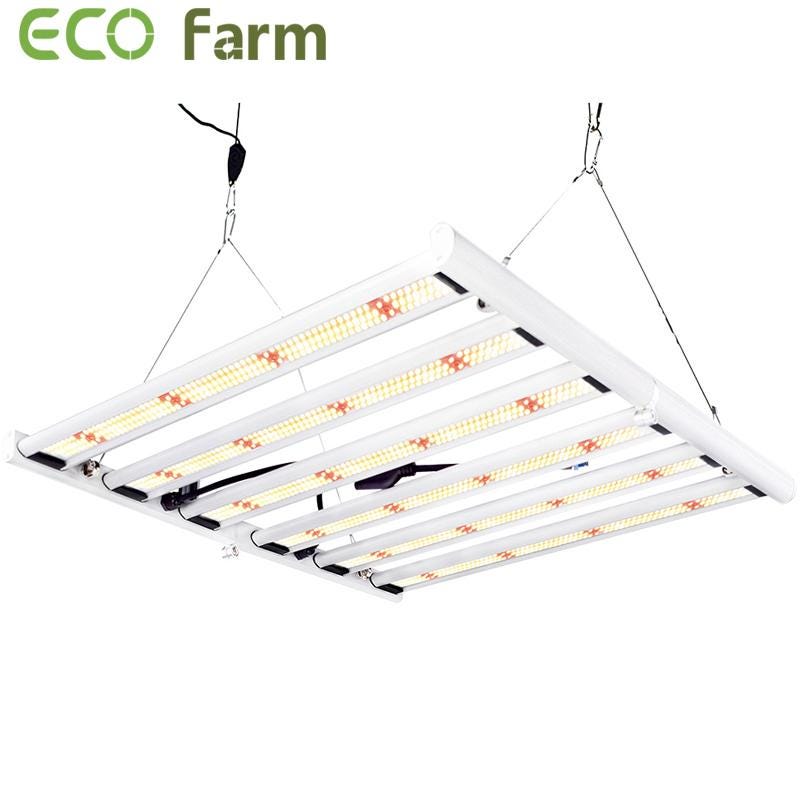
Features:
This ECO Farm LED grow light with upgraded SMD 3030 chip 6 passive-cooled led bars, higher light intensity, less light decay, better lumens, and PAR values than ordinary LED chips. FLD 320W uses 1200 LED chips that consume only 320W, perfect coverage for 3x3ft, helps you achieve maximum quality and quantity. The intensity of light can be adjusted according to the needs of plants. It can be freely adjusted lighting intensity as plants need growth at different stages with dimming options ranging from 0 to 10 levels. SMD leds spectrum is white 3000K leds, white 5000K leds, 660nm red led, and 740nm IR leds. Master light is easily controlled for commercial & home horticulture.
Spectrum King Phoenix 340W LED Grow light
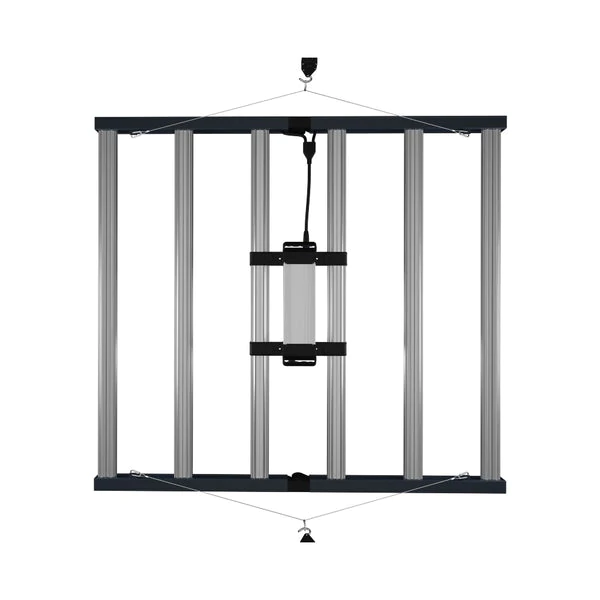
Features:
Spectrum King grow light is the most efficient LED light fixture on the market with a dedicated plant spectrum. SK Cryo-Therm cooling technology enables ultra-thin profiles, maximizes airflow and minimizes microclimates. It has unmatched performance and reliability in its class. It is optimized for single or multi-level planting near the canopy. The Spectrum King Phoenix 340W Veg sets a new benchmark for what’s possible with grow lights. The full spectrum is ideal for most light-loving plant seedlings, vegetation and the entire growth stage of flowering. IP65 waterproof horticultural lighting system, can be used in humid or water vapor environment, easy to use, plug and play.
Neocision Spectra Explorer 340W LED Grow Light-BVV
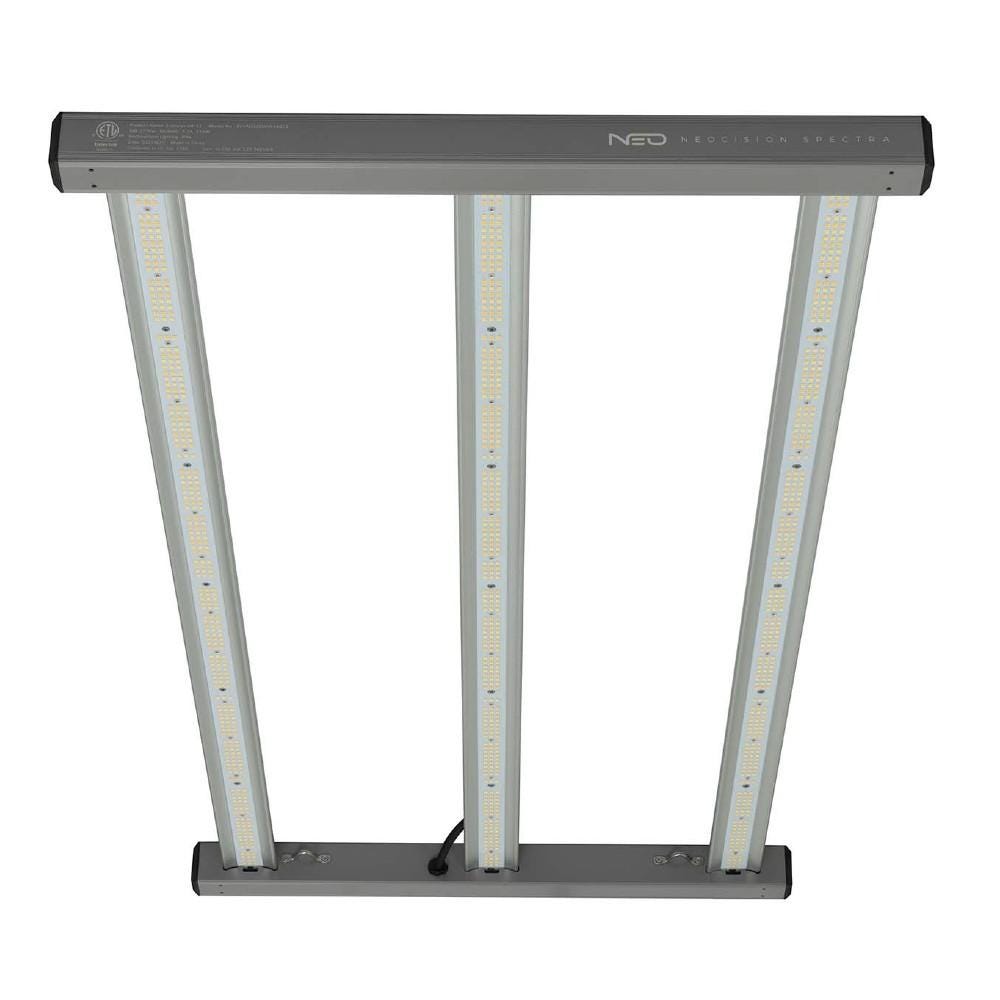
Features:
This BVV grow light is designed for a full grow cycle with maximized red for increased photosynthesis, and effectively promotes plant leaves, stem growth, and flower yield. The full spectrum, infinite close to natural sun light, is suitable for all stages of indoor growth of all plants, accelerating flowering time and increasing yield! Ideal for 2’ x 4’ tent environments for increased consistency and yield. Using the most advanced SMD LED technology, to provide high PAR output, high energy efficiency and long life while improving light transmission. Comparable to a traditional 600W HPS or CMH light. Save up to 70% on your electricity bill.
Why is grow light distance important?
“The intensity of light is inversely proportional to the square of the distance”. what does that mean? This means that small changes in the distance between your lights and plants can result in huge differences in light intensity.
If you grow plants, you know that your plants need a lot of light. As simple as more light equals more productive plants equals higher yield. But hang the lights too close to the plants, and this can cause problems.
The key here is to find the perfect distance that supports optimal yields without compromising plant health. You don’t want to be stressing or burning your plants all the time. Things are complicated by the absence of general recommendations for the best (and safest) light distances for growing plants. The reason for this is that not all grow lights are created equal.
With some types of grow lights, such as CFLs, safe distance is not as much of an issue. You can place grow lights as close to the plants as possible. Other lights, such as HID grow lights, emit a lot of heat, so there must be enough distance between the canopy and the grow lights. Then there are LED grow lights, which emit a lot of light but don’t run too hot.
Also, the optimal distance depends on your light intensity and where the plant is in its growth cycle. Ultimately, though, whatever grow light you have, you want to hang it as far away from the plants as possible.
Factors That Affect LED Choice
There are two factors that you need to consider when choosing the wattage of the LED Grow Lights.The first would be the plant you’re growing, and the second would be the total area of your grow space.
Type of Plant
Plants have different lighting needs, which is why you need to know how much light a plant needs. As a rule of thumb, the higher the wattage, the more intense the light is. Leafy plants and herbs usually need lower wattages. Fruit and flowering plants like tomatoes need higher wattages. The amount of power you need for leafy plants would often be half of what a flower-bearing plant needs.
When it comes to the total grow space area, this pertains to how much space your plants cover and not the footprint of your space. That will help you also decide how much wattage you need for every plant.
Different growing techniques are a consideration in the total area of growth. And while that affects wattage, you can’t just split the light to get the right amount of power. Instead, you can use that light in a position that can help benefit multiple plants.
So, how much do you need per plant per area?
Thirty-two watts of power should be enough for every square foot as a rule of thumb. You can go a bit low to 30, but don’t go beyond 40 per square foot. So how good is a 32-watt LED?
Let’s take the Screen of Green technique as an example. A Screen of Green needs about 0.25 square feet of grow space. With a 32-watt LED grow light, you can provide enough lighting for four plants. For a Sea of Green, the same 32-watt grow light can provide lighting for one plant.
On the other hand, 32-watts of power won’t be enough for a low-stress training, which occupies at least two square feet of grow space.
As you can see, you can use a grow light for multiple plants. But take note that it’s not ideal to do so all the time. For one, the lighting coverage on the outer part of the light’s footprint isn’t as beneficial as being close to the center. And while you can cram plants under a grow light, the results won’t be as helpful.
Sounds simple? There are some considerations to consider with the grow space and wattage.
Photosynthetically Active Radiation (PAR)
PAR, or photosynthetically active radiation, is just as important to know when deciding how much lighting you need to grow your plants. PAR measures the intensity you need to grow your plants. To give you an idea, leafy plants need around a PAR of 200, while fruit-bearing plants would thrive between 400–500, depending on the plant.
Knowing how much PAR a grow light has will affect how a plant grows. If the PAR is too low, your plant will have a hard time growing and will likely have stunted growth. Too intense lights, meanwhile, can burn your plants. That’s why LED grow lights need to be set at an optimal height, even with the lower heat emission.
Conclusion
Keep in mind the various grow lights for different stages of plant growth:
Choose white light for all stages of the plant growth cycle
For early growth stage lights, choose blue grow lights
If you want to promote flowering, red grow lights are the best choice for you
Whether you’re permanently growing your plants indoors, or growing them outdoors indoors, grow lights can help keep your plants healthy. Hopefully we’ve given you some ideas on how to use grow lights for your houseplants.
